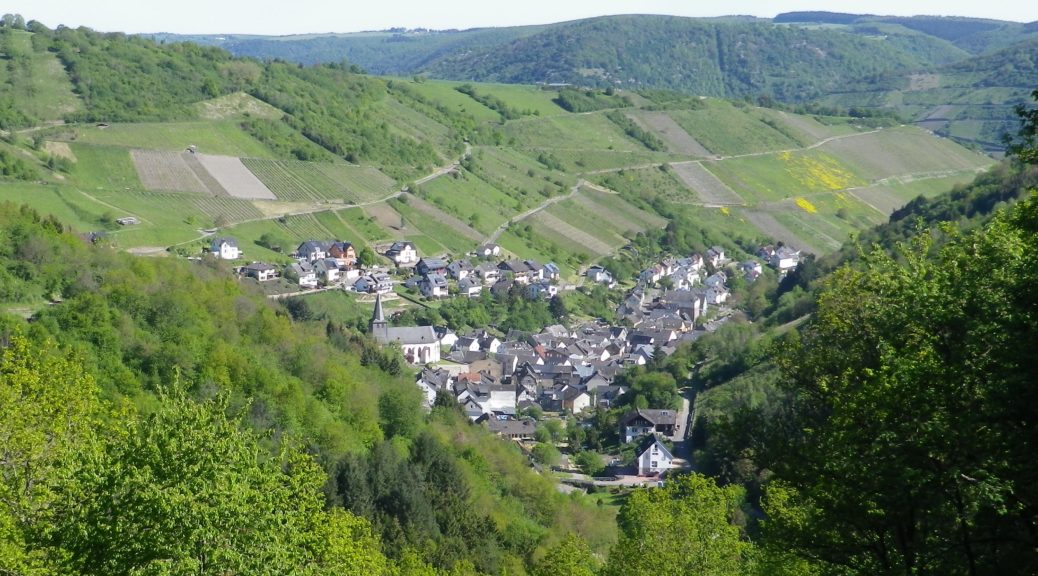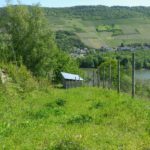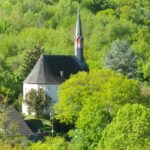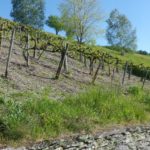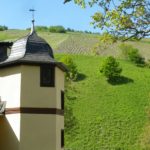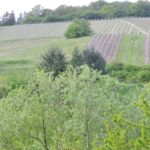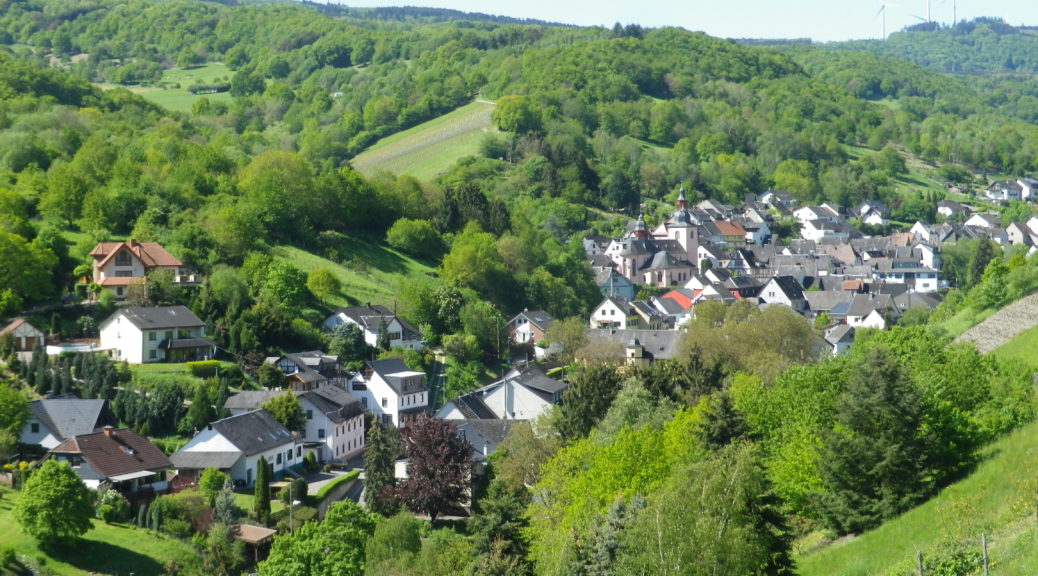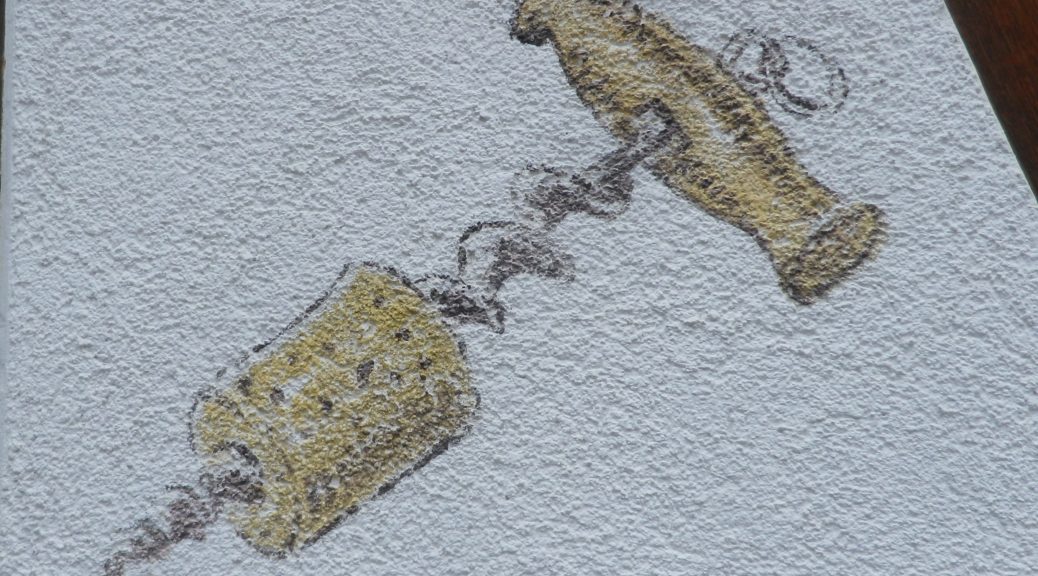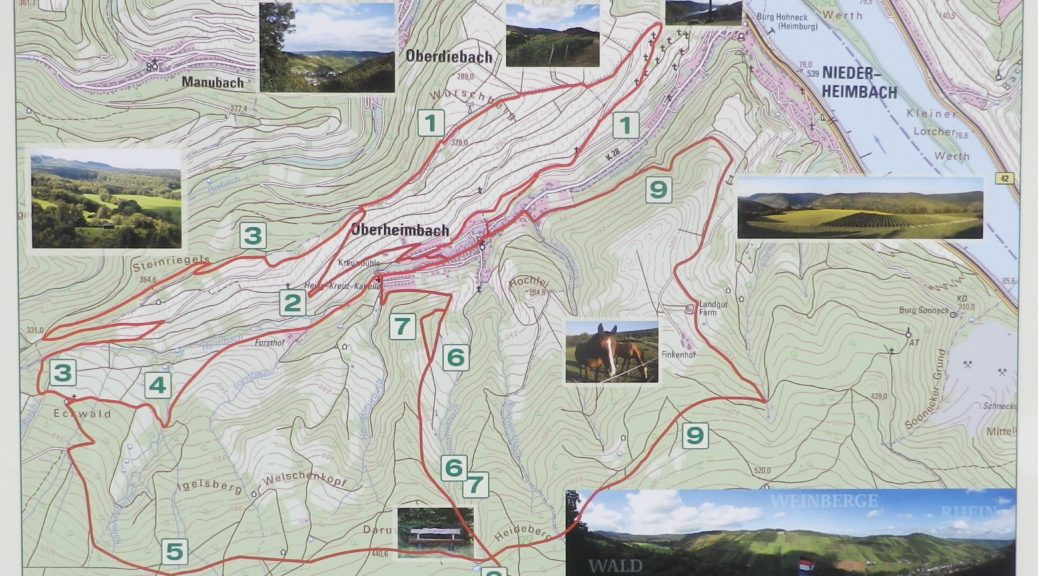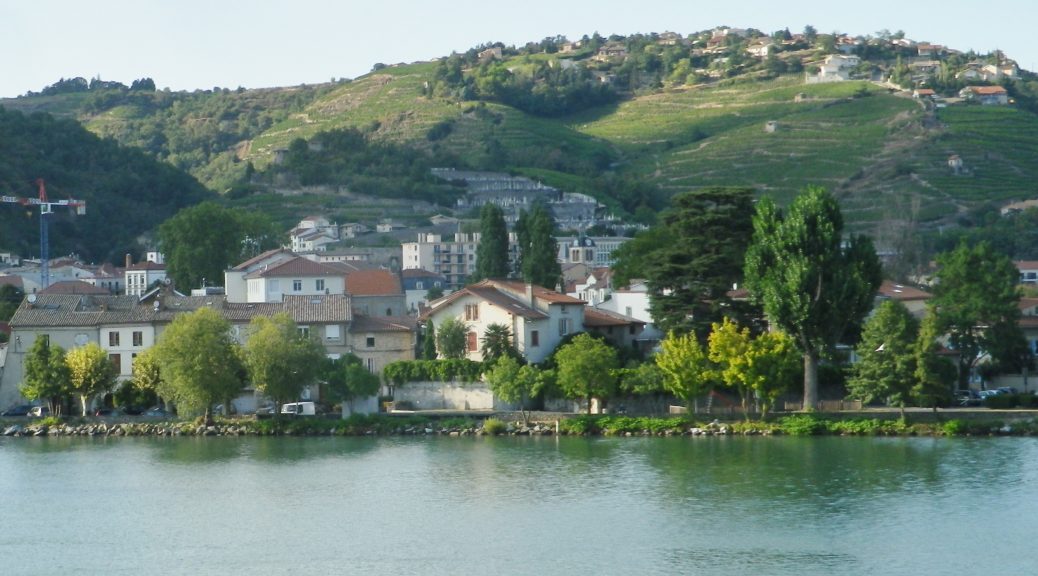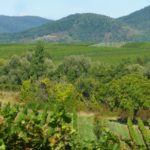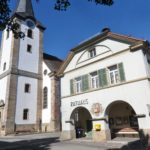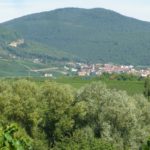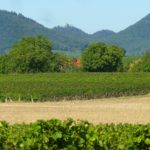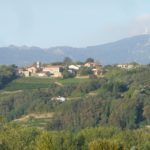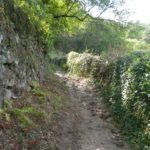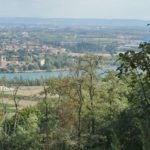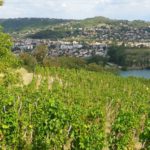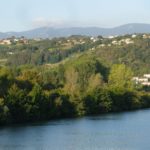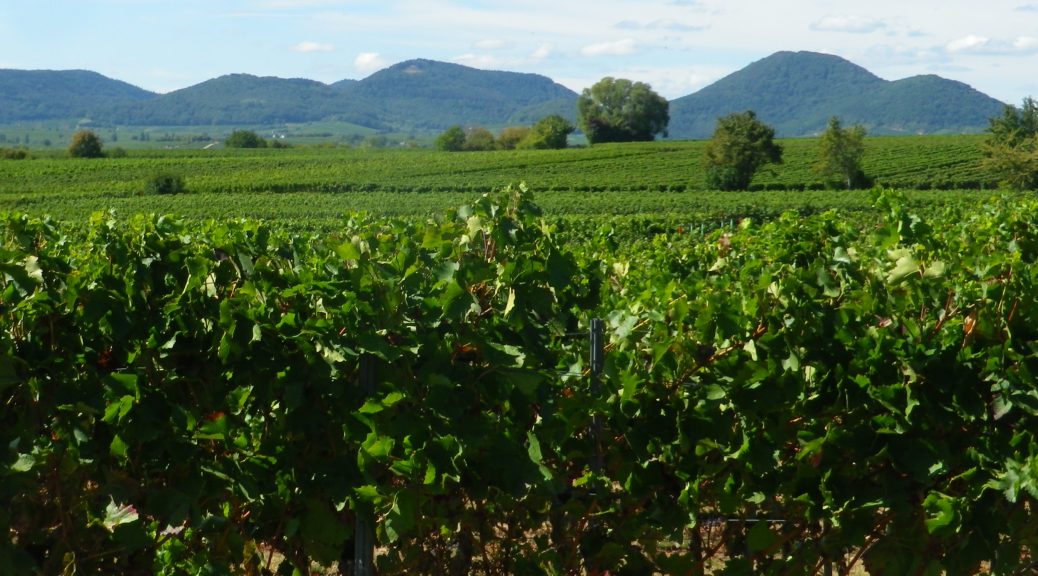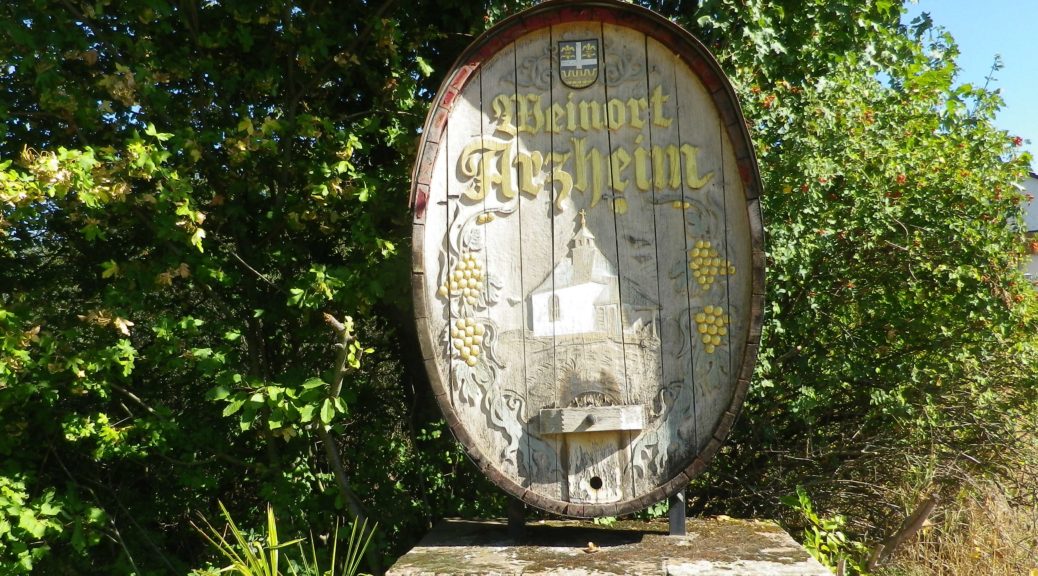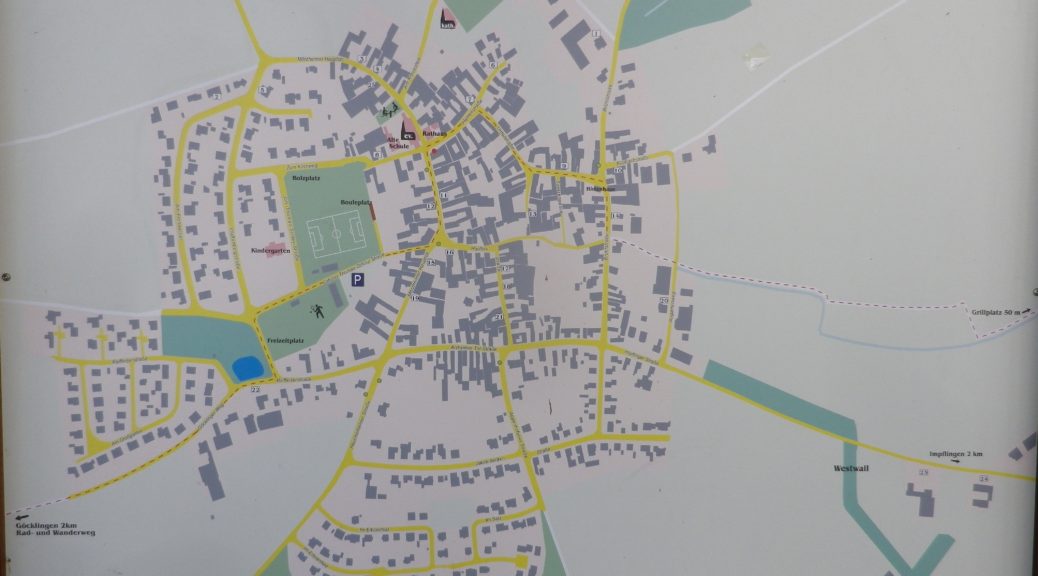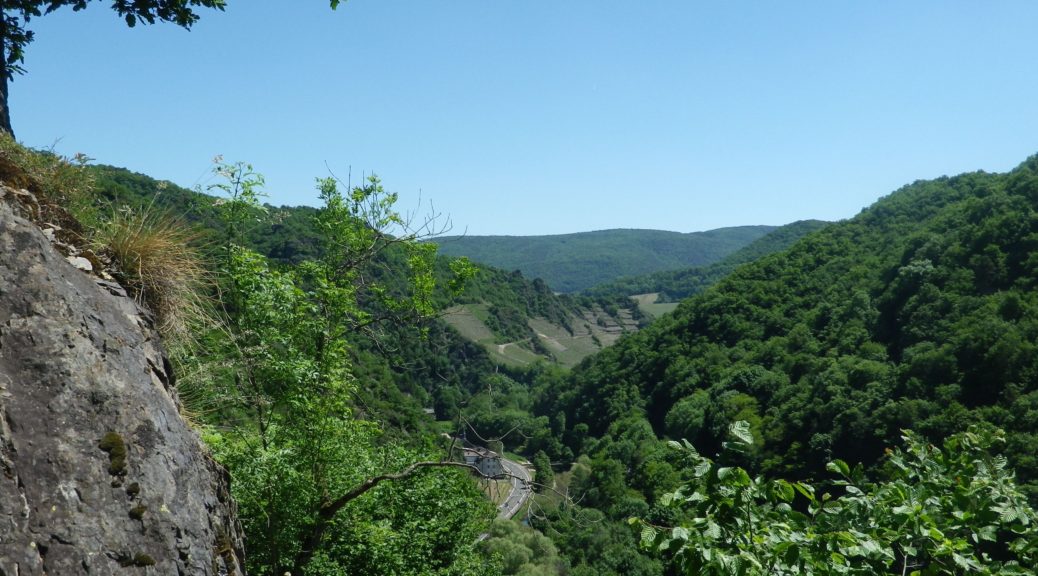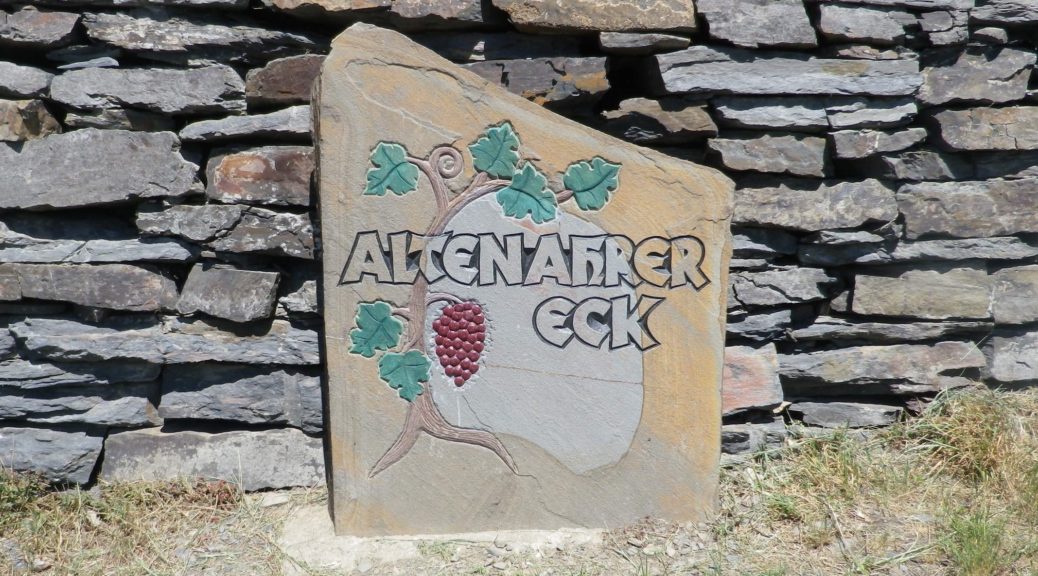Tag Archives: Rheinland-Pfalz
Vines on the Rhine
Readers may have noticed that there are many hiking trails through vineyards in the whole of the Rhine River Valley, in Germany, France and Switzerland. However, many of the vineyards in the Rhine River Valley, are not necessarily close to the river, especially since the valley is especially wide where the river flows between France and Germany. Hence Alsatian vineyards in France, and the Baden vineyards in Germany can be miles away from the river.
But it is a very different picture (and view) indeed, when hiking or biking through the northern Rheingau or southern Mittelrhein wine regions. Previous hikes through the Rheingau (on the east/right bank of the Rhine) on the fabulous Rheingauer RieslingPfad (see here, and the photo below), left me wanting to see more, and from a different perspective. I began with the southern-most vine growing area on the west/left bank of the Rhine, where the Reblausweg Trail provides nice views of both the Rheingau and Mittelrhein vineyards just across the river.
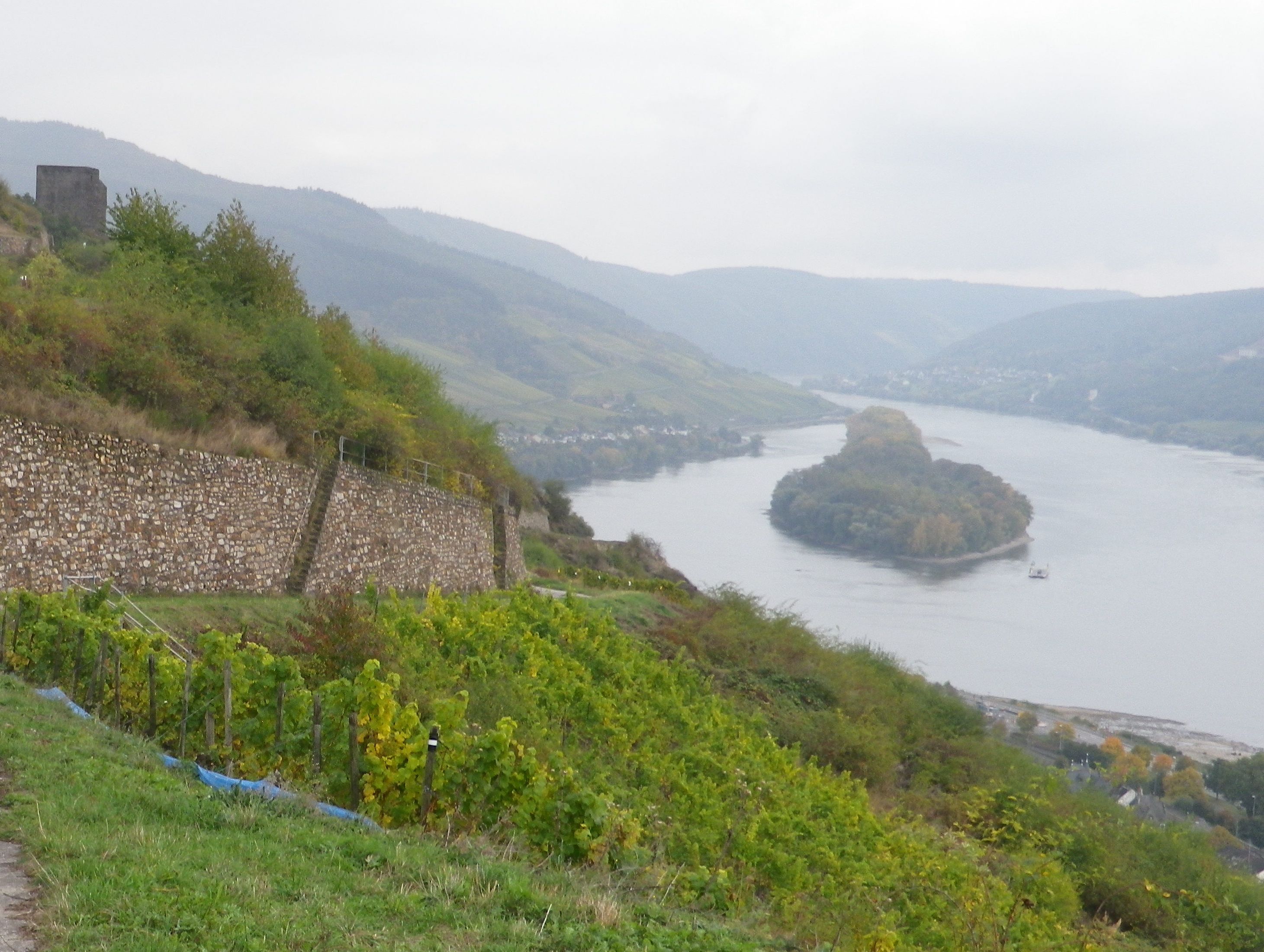
Wine Notes: Mittelrhein Reichenstein
What I Learned
The Mittelrhein (Middle Rhine) is famous for its dozens of castle ruins, towering cliffs, and dramatic oxbow bends along the course of the Rhine through this section of it. The Upper Middle Rhine is now a UNESCO World Heritage site. It begins in Koblenz, and continues to Bingen.
This also defines the wine region known as the Mittelrhein. Unlike other wine regions on the Rhine, this region covers both banks of the river (beginning north of Lorchhausen, which is part of the Rheingau region). Many areas of the Upper Middle Rhine do not produce wine: the topography and geology just aren’t suitable or practicable, even for growing other crops. That just makes the vineyards along this section of the Rhine even more esteemed.
Reblausweg: Trail in a Nutshell
Trail Name: Reblausweg (Nr 13)
Trail Type: Short distance circuit; well-maintained and mostly paved or hard-packed earthen trail, marking on the trail is mostly good, but not specific to this trail
Length:
Total – 7.8 kilometers/miles
Convenient to: Bingen, or Koblenz, Germany
Marking:
Nothing specific to the Reblausweg trail, but directional signs, and marking for the Panoramaweg trail (which this trail partly follows), are both helpful.
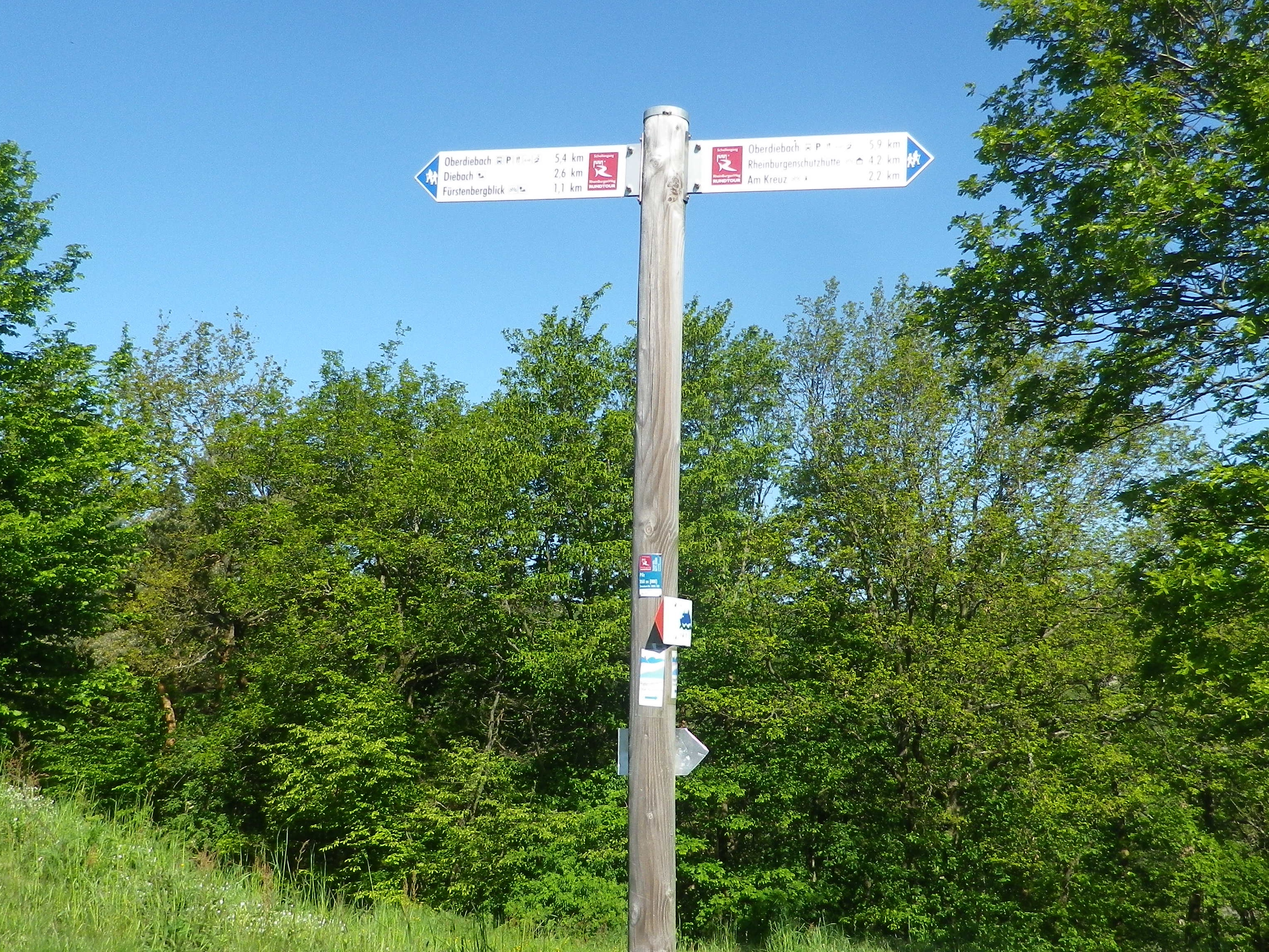
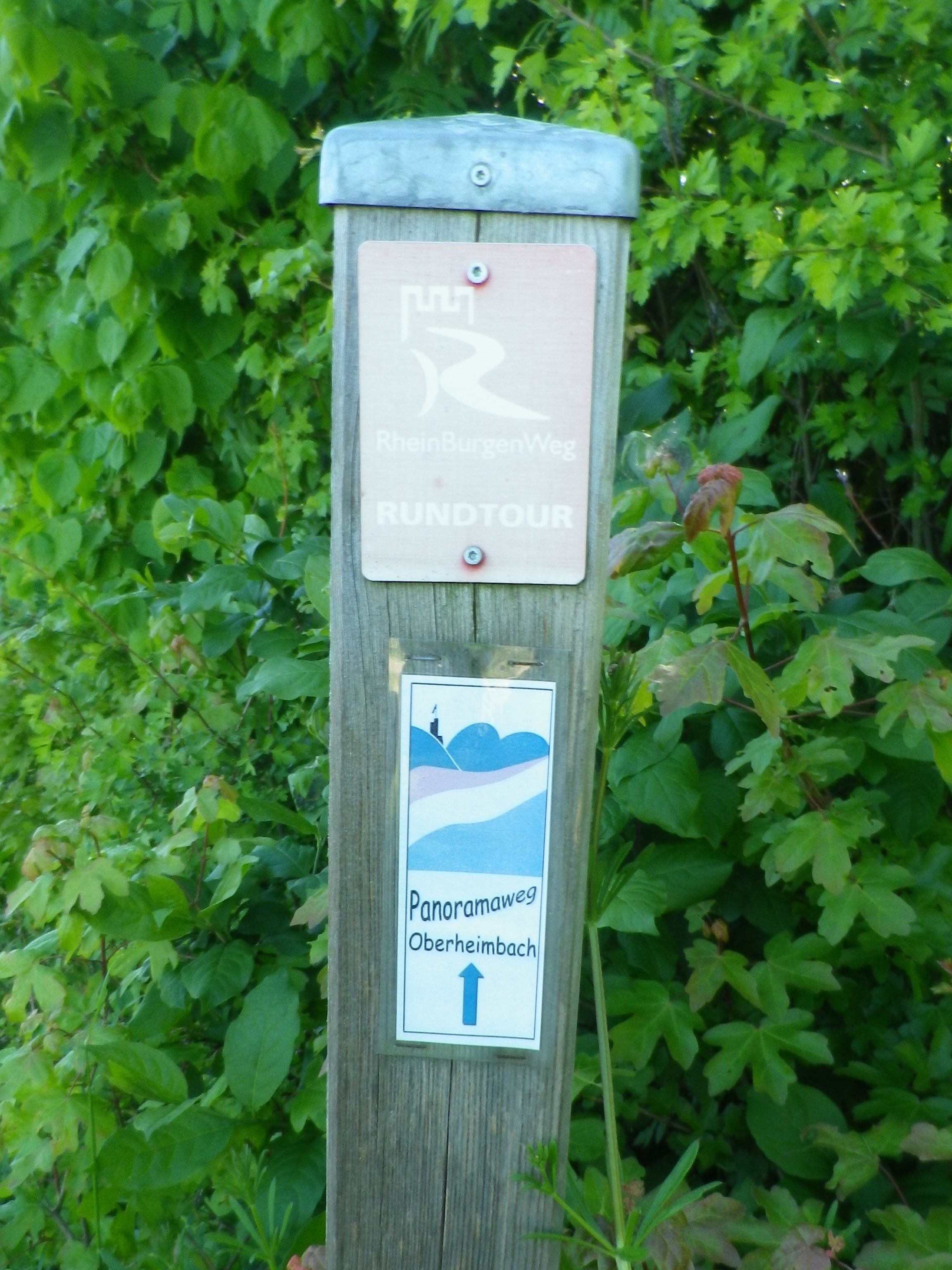
Gallery September 2020
Vintners and Their Vines
As anyone who earns their living by the soil will tell you, the fields are important. As those who make their living by grapes know, each individual parcel of the vineyards is very important and rather unique. Like most vintners, those of Suedliche Weinstasse feel a deep connection with the land, and attempt to maximize the potential of the terroir and microclimate for each parcel, and carefully match that with each varietal planted. Parcels may be adjoining, or separated by a couple of kilometers. To access these, vintners use agricultural lanes, most of them as well tended as the vineyards they serve.
This bicycling itinerary led mostly along these lanes, through acres of vineyards, both in prime condition. The itinerary was called the Winzerradrundweg, or Vintner Bicycle Circuit Trail. Previously, vintners and vineyard workers, usually family, may have ridden bicycles to access distant parcels. Today though, they use cars, and compact trucks, and cyclists use these quiet lanes to explore this beautiful countryside.
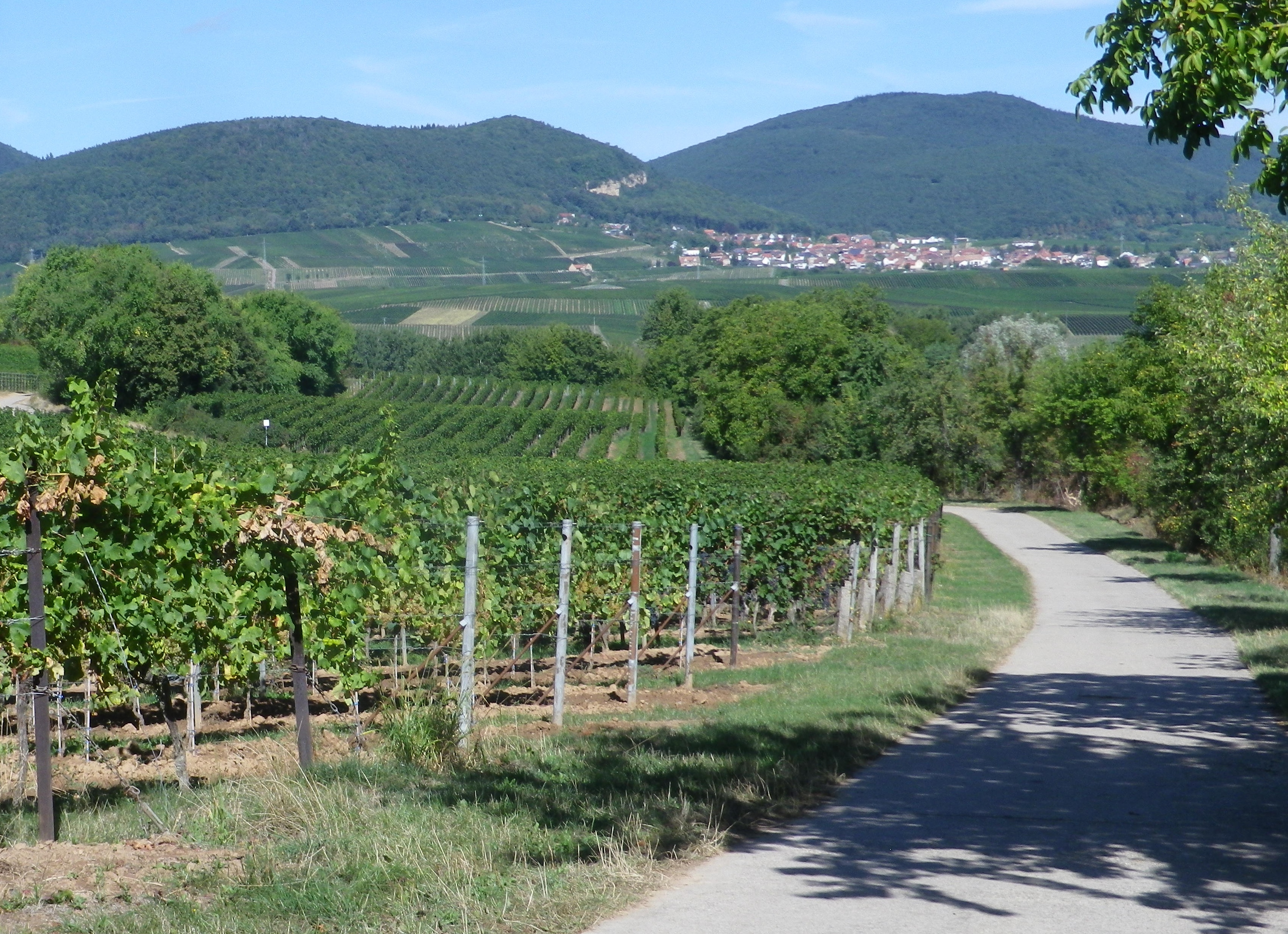
However, starting in the city of Landau in der Pfalz, the first two or three miles pass through wheat, corn and cabbage fields. There, I had my first encounter ever with a (John Deere!) farm combine. Curving upward from a steep gully, lined by high hedgerows, I first heard it, then only saw it, as it barreled down toward me on a lane rather narrow for it, let alone me and it. This thing was huge, about two stories tall! Happily, it suddenly veered to the right to begin harvesting the corn in an expansive golden field. Sadly, I didn’t get a photo. Shortly thereafter, I entered vine country, where such large machines are not used, not in Germany at least.
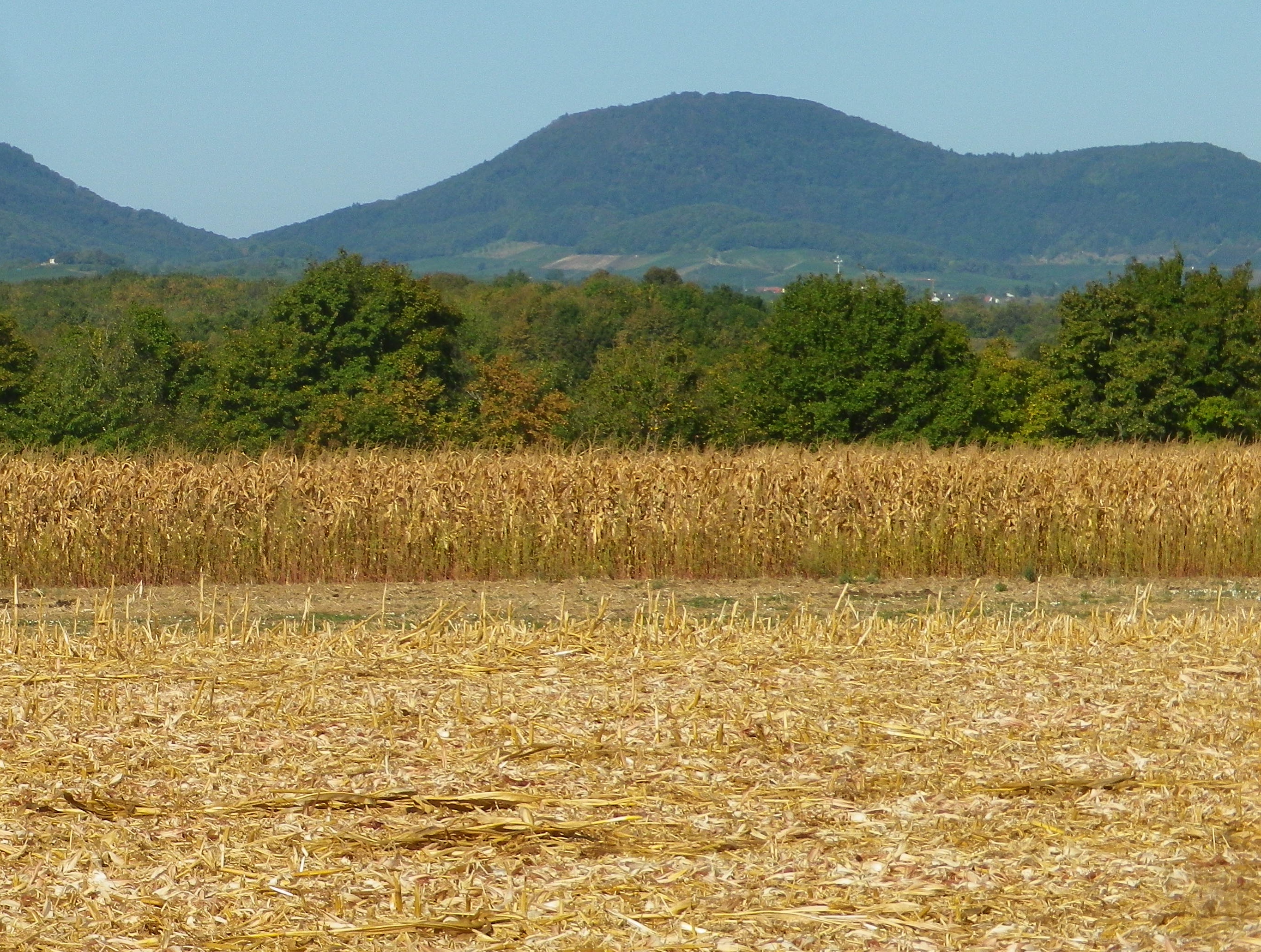
Two things to notice on this itinerary: the terrain for vines is distinctly different than the terrain for fruits and vegetables. The vineyards started where the flat fields left off, and hills or ridgelines began. The other noticeable difference was in the composition of the villages: the vintner family houses and businesses tended to be set in the villages, whereas the farmers tended to live on the edge of town.
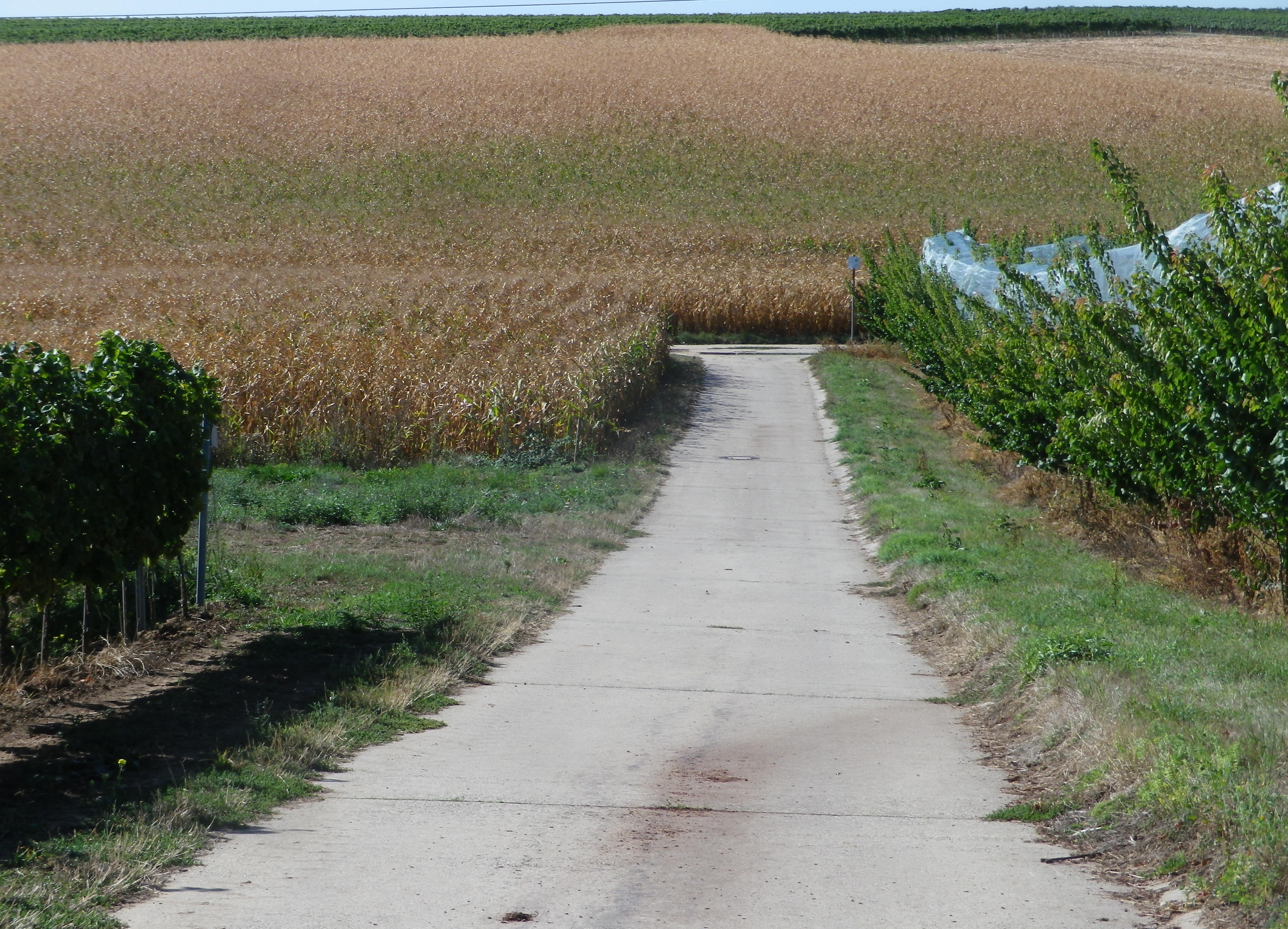
Going through the first vineyards, I noticed that harvest had yet to begin. The vegetation, last cut back weeks ago, while trim, was lush and now filled out. The grape bunches hung heavily on the vines. These vineyards while full of grapes, were empty of people. Presumably, the vintners were at the wineries, busy preparing the equipment and cellars for the harvest soon to come.
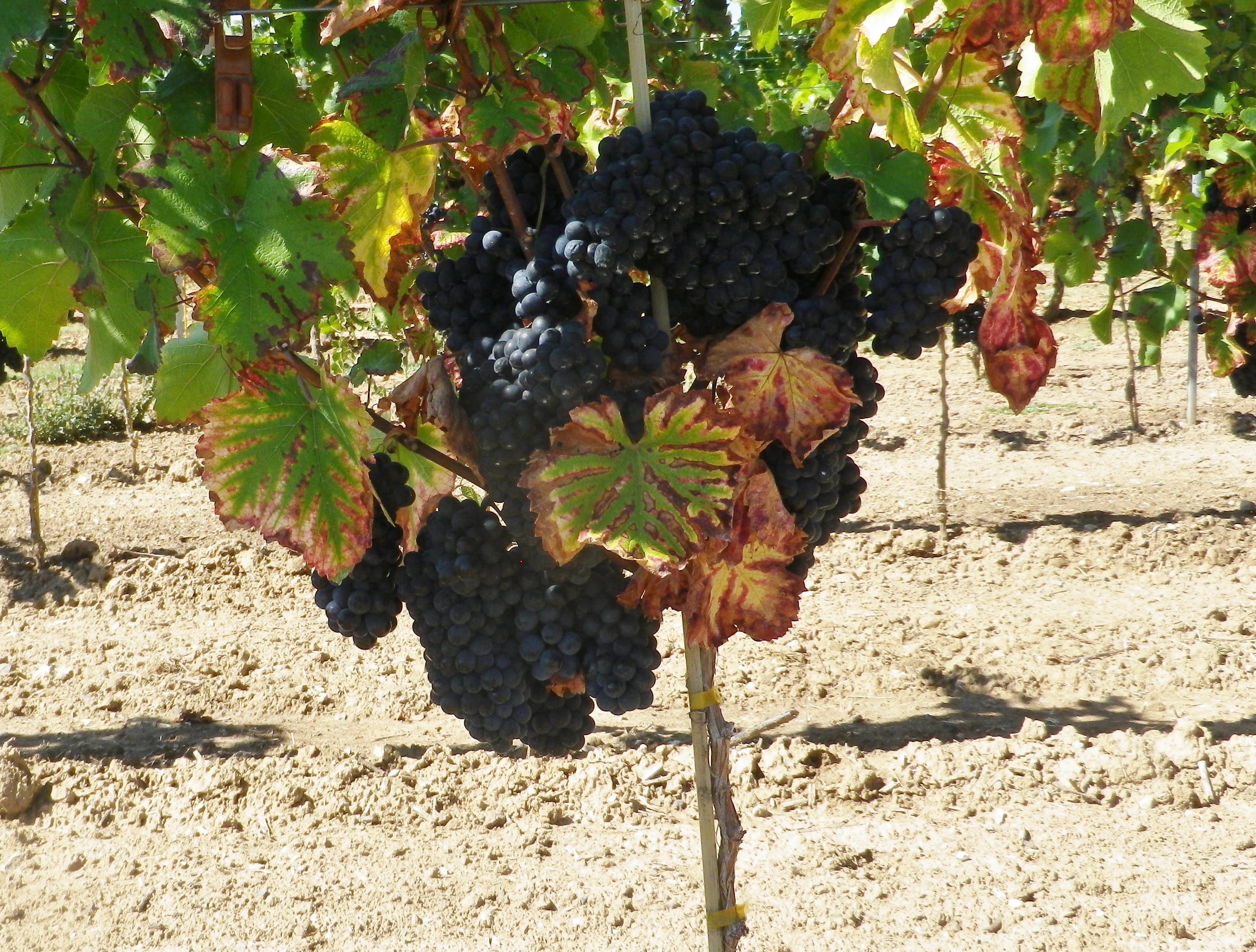
At first, the vineyards were interspersed with corn or vegetable fields in the flat areas in between. This area is one of the “garden” spots of Germany, so there is a diverse agricultural scene here. This was especially true around the villages of Insheim, Knoeringen and Dammheim. But that began to change as the trail approached the base of the Haardt mountains.
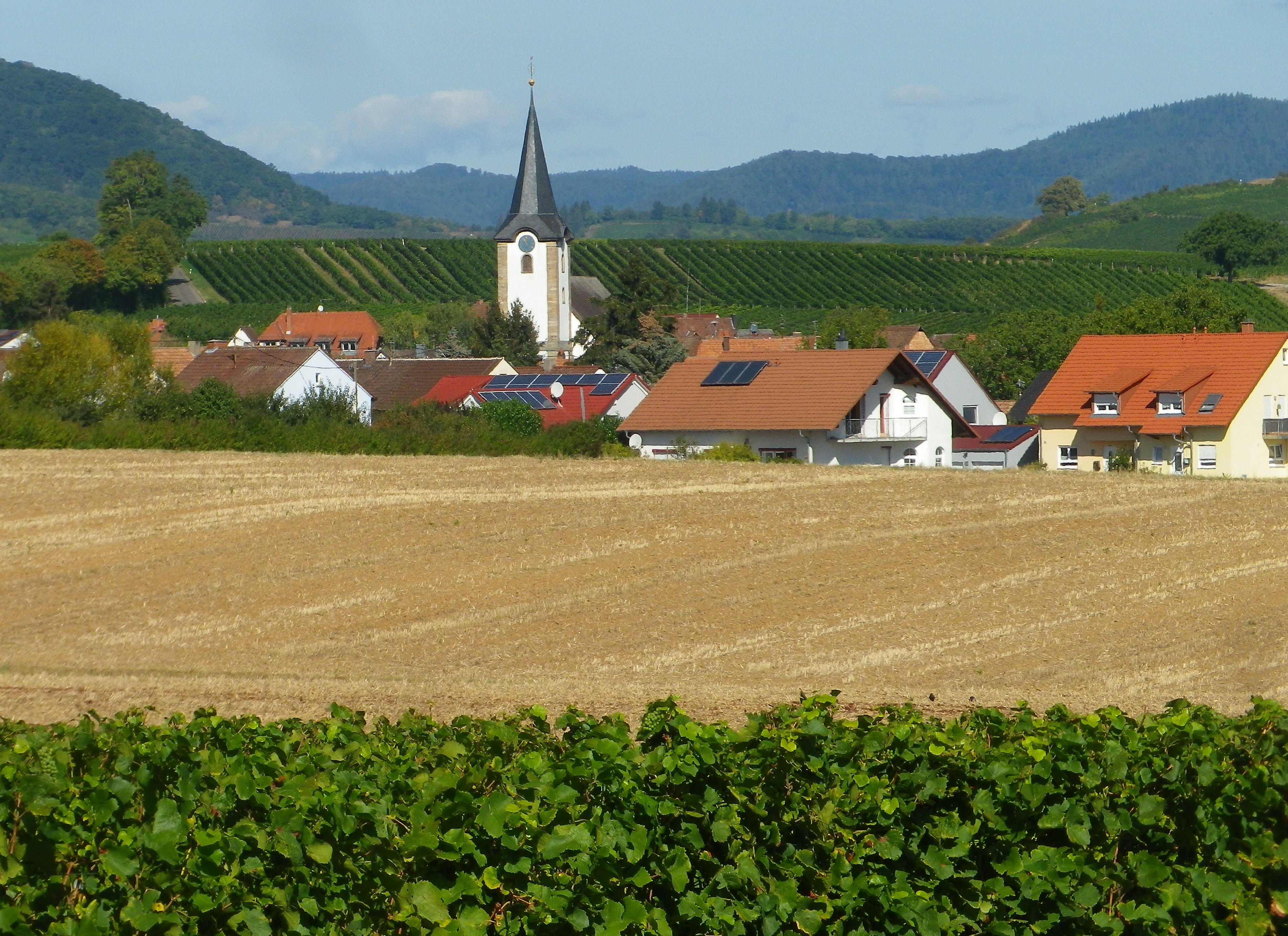
The vineyards predominate once west of the village of Moerzheim. Kilometers of vineyards, each sited with precision, arrayed magnificently along the vintner lanes, which were proving ideal for cycling. The lush green vegetation looked gorgeous under a brilliant sun and a clear blue sky. They were interrupted only by the neat and compact winemaking villages of Wollmesheim, Ilbesheim and Arzheim. Once I reached Siebeldingen, I was at the home of German grape varietal development, the Institut fuer Rebenzuechtung, where experimental new varietals are scientifically engineered, cultivated and tested every year.
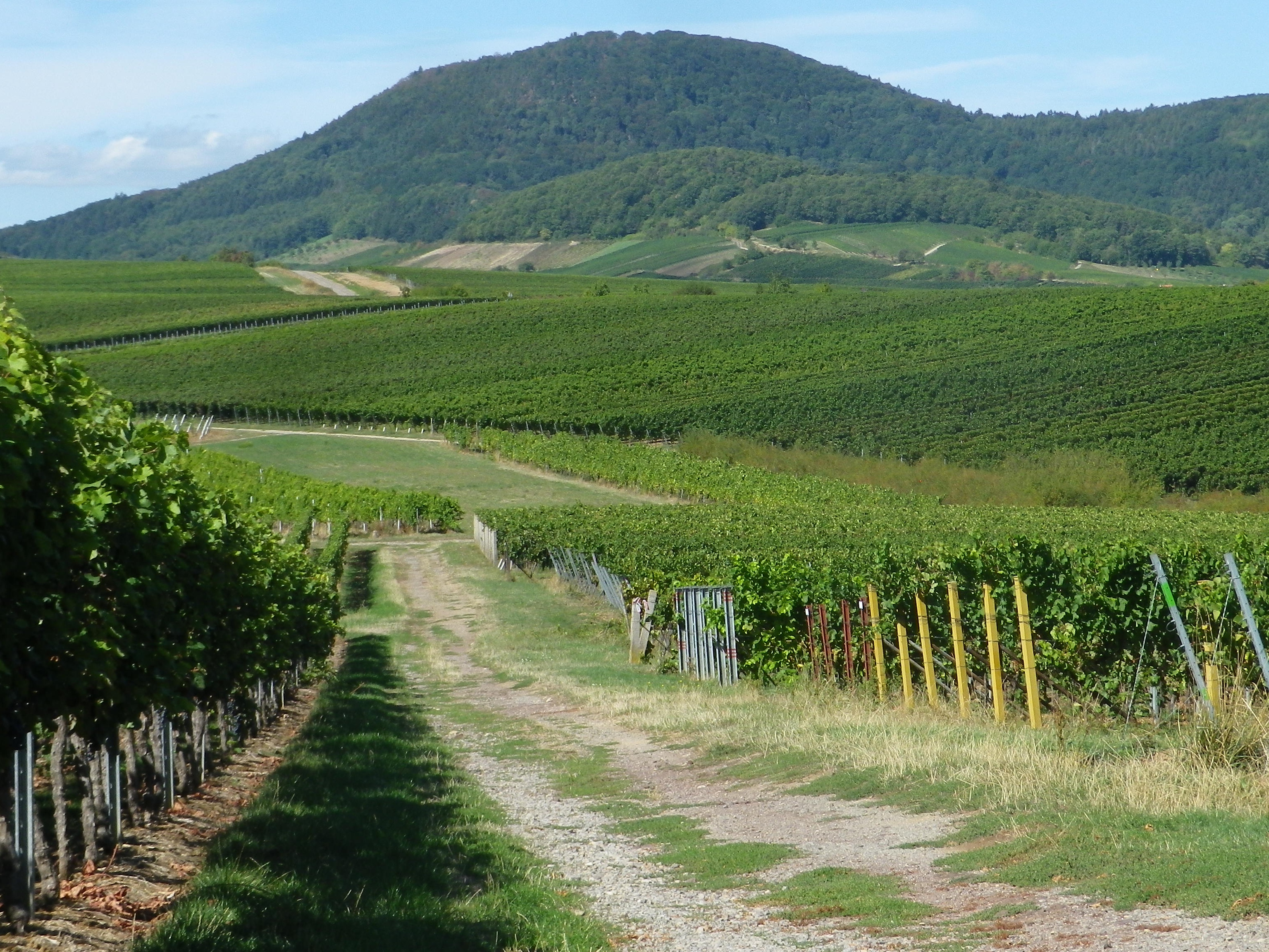
The itinerary followed up and over ridgeline after ridgeline. On top of each ridgeline, the views were tremendous. The flat lands of the Rhine River Valley stretched east to Baden-Wuerttemburg, where the base of its tree-lined ridges stood out well on this crystal-clear day. Seemingly near enough to touch, stood the Haardt mountains to the west. Some of its beloved red sandstone landmarks clearly stood out against its dark pines. There could not have been a better day for cycling this trail.
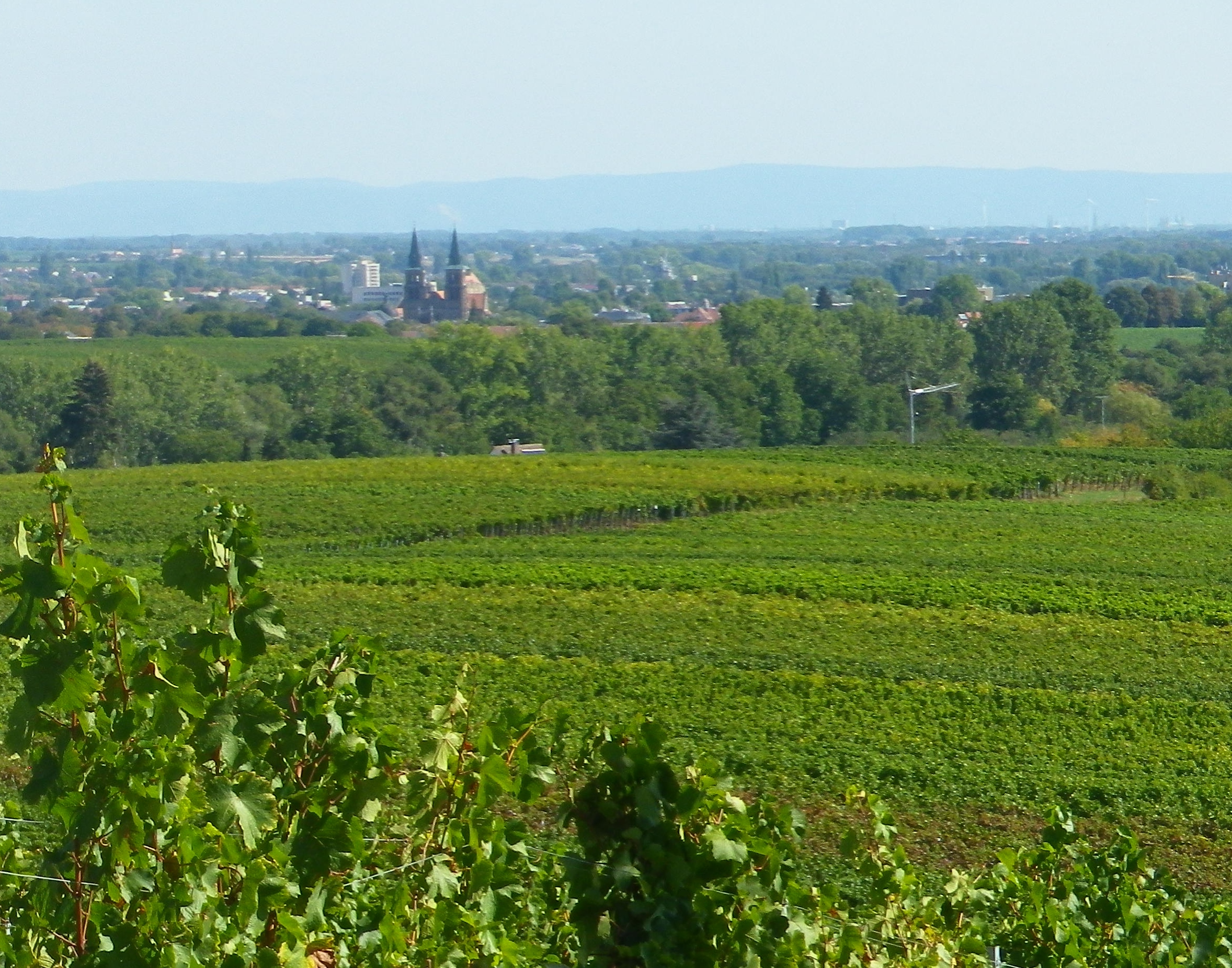
The occasional village provided opportunities for something to eat or drink. But the village of Nussdorf really stood out. Set in a sea of vines, this little village which once sheltered Roman-era vintners, really celebrated its viticultural heritage. Nussdorf’s unique wine education trail (Weinerlebnispfad), complete with picnic benches, a wading pool for aching feet (Kneipp), and a rest area, also partly served as the itinerary for this section of the Winzer Radrundweg. There were several sculptures celebrating the life of the vine, and chimes lined the trail, awaiting the inspirational touch of passersby to bring sound to the vineyard. Flowers, usually roses, marked the end of rows of vines. (Historically, vintners used flowers to lure insects away from the vines, thus protecting them.) Speaking of celebrating, in addition to hosting several wine festivals throughout the year, some enterprising local vintner also had what looked like a large prairie schooner (Planwagen), apparently rented by a group of partygoers, enjoying the local wines as they were drawn along the wine trail.
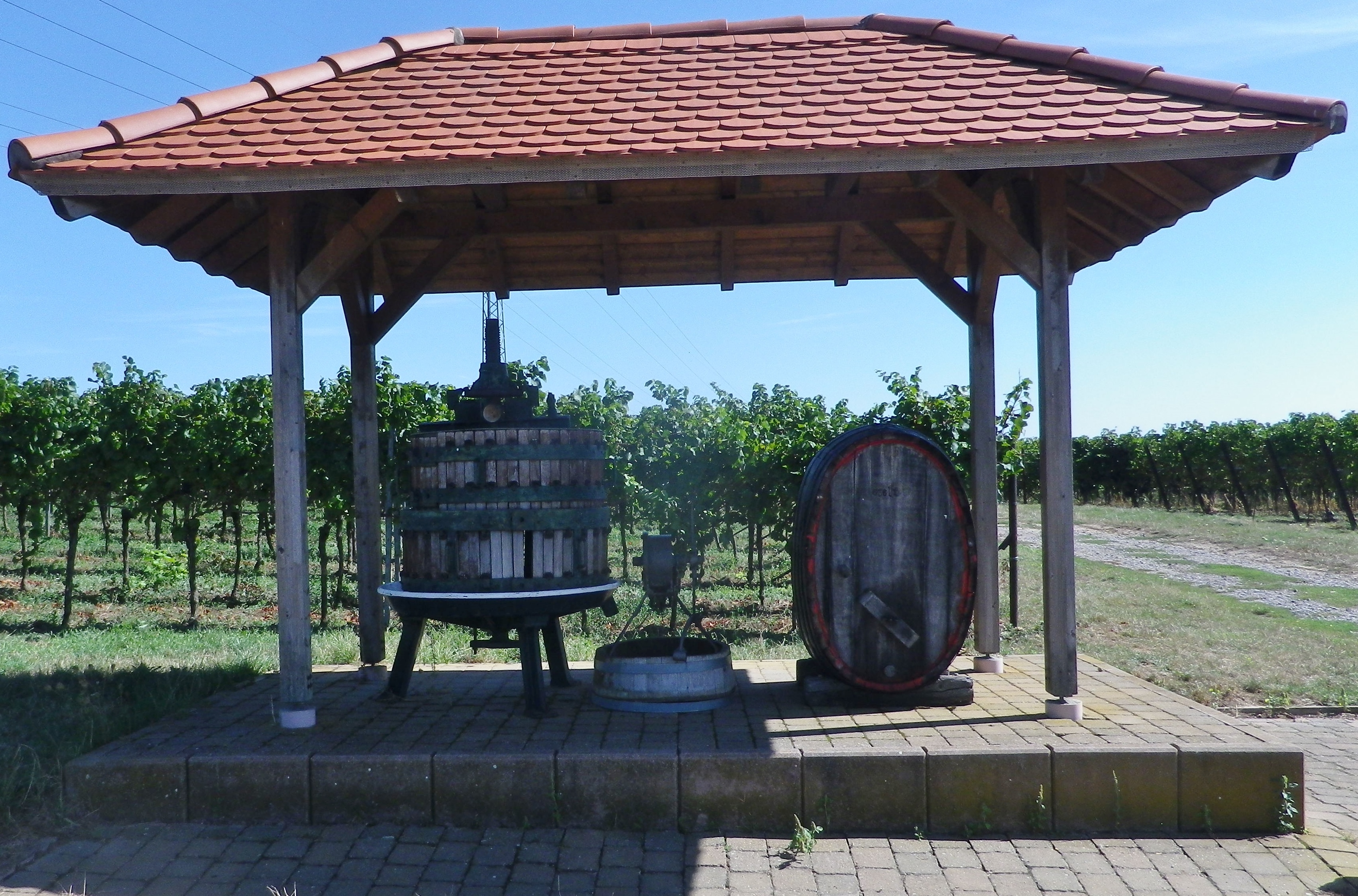
A good time on the trail was had by all that day, especially by me. This trail provided a wealth of sights and sounds, a variety of landscapes, and above all, a variety of wines to sample and enjoy!
Wine notes: Pfalz’s Suedliche Weinstrasse
What I Learned:
The Pfalz Wine Region has a long history of wine making. The pressing room and vats at the Weilberg Roman Winery (Römische Weingut Weilberg), near Bad Duerkheim, and the implements found throughout various sites all along the Deutsche Weinstrasse, testify to this long history.
The tradition continued with the establishment of regional monasteries, such as the ones in Klingenmuster and Wissembourg dating to the 600s. This was especially true along the Pfalz’s Suedliche Weinstrasse. Wissembourg was a rich and powerful monastery in its day. In today’s Edesheim, the abbey owned the “Villa Auduino,” which consisted of an agricultural manor house and two churches. In Nussdorf, the Monastery of Fulda (far to the north) owned its own manor house. These places were important to the monks, not just for providing food products, but also for their wines, which they needed for liturgical services.
Hence, in the Suedliche Weinstrasse district, winemaking has been an important economic activity for about 2000 years. Not only has this area had an uninterrupted history of winemaking, it also continues to modify and improve its traditions over time.
Siebeldingen’s Institut fuer Rebenzuechtung (Institute for Grape Cultivation) Geilweilerhof (the building itself a former cloister) is an invaluable resource in this regard. The institute maintains databases on grape varietals, and has test cellars to make and test wines from new varietals. This all supports its main function: to develop new varietals, genetically resistant to climatic changes and pests.
Some of its older creations will be familiar to lovers of German wines: the white varietals of Morio-Muskat and Bacchus, and the red varietals of Domina and Regent (two of the most flavorful and powerful German red wines, IMHO). One of the newest grapes to come onto market as wine is the white Calardis Blanc, a cross between a Bacchus and Seyval Blanc, and a Seyve Villard. (Finding a bottle will be a challenge for a few years to come, so head to the Institute’s wine shop in Siebeldingen for now!)
Over 125 varietals are planted in the Pfalz wine region, to include the ones listed above! But only half a dozen or so make up over 60 percent of the plantings. Riesling has always played an important role, but more so in the northern part of the Pfalz wine region. Mueller Thurgau is also an important white varietal, especially so in the south. Weissburgunder (Pinot Blanc) is another white wine grape that is planted here, although in far smaller quantities. As for the red varietals, there is Dornfelder, the most widely cultivated red wine grape locally. As a percentage of red wine grapes grown, it has overtaken the traditional favorite: Portugieser. Spaetburgunder, aka Pinot Noir, represents a full 7% of the grapes planted, and is gaining in popularity.
What I Tasted:
2017 Gruener Silvaner, Ortswein, Trocken, Weingut Voegeli (Wollmesheim): A dry white wine with a medium yellow gold color; a mineral nose, with herbal, grass, spice and slight pear flavors; medium acidity, with a tangy finish.
2017 Chardonnay, Lagewein, Trocken, Weingut Voegeli: A dry white wine with a medium white gold color; a peach, honey and mineral nose, with peach, pear and floral flavor; medium acidity, with a smooth finish.
2016 Riesling, Lagewein, Trocken, Weingut Voegeli: A dry white wine with a medium gold color; a slight mineral and turpentine nose, with spice and green apple flavors, medium plus acidity, with a crisp, tart finish.
2012 Weissburgunder Sekt: Weingut Wilhelmshof, (Siebeldingen): A sparkling white wine with lively, persistent perlage and medium gold color; a powerful fruity nose, with powerful fruity grape and white stone fruits flavors, a medium and sweet finish.
Winzer Radrundweg: Trail in a Nutshell
Trail Name: Winzer Radrundweg
Trail Type: Medium distance circuit cycling itinerary; well-maintained and mostly paved trail surfaces, albeit with a couple of grass paths, and a few hard-packed earth surface sections, marking on the trail for the specific itinerary is sporadic.
Length:
Total – 44 kilometers/27.3 miles
Convenient to: Landau in der Pfalz, Germany
Marking: A white sign with stylized circles forming a grape cluster with two stylized riders on top
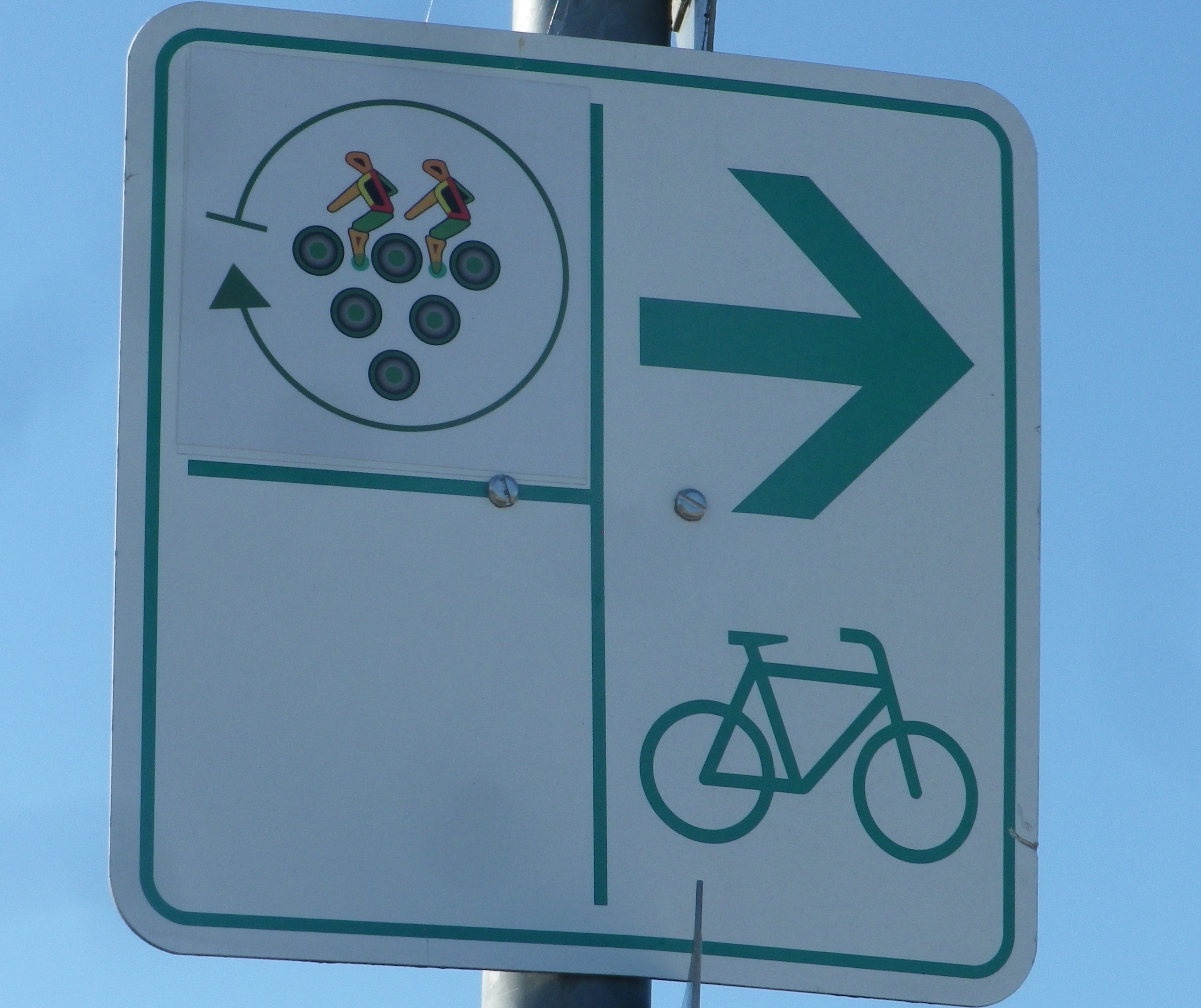
Trail Description: A delightful medium-length circuit primarily through vineyards, circling around the smaller, and lesser known (hence quieter and not as tourist-filled) wine villages of the southern part of Deutsche Weinstrasse.
Trailhead:
Official: Siebeldingen: Bismarckstr
Mine: Laundau: L509 Queichheim Hauptstr, at the Landau Zentrum exit off A65
Parking:
Insheim: Bahnhofstr;
Moerlheim (at exit Landau-Zentrum): P+R (just east of exit)
Landau: parking in and around the Freizeitbad (a water park) and the nearby Stettiner Str
Public Transportation Options:
Rail: Deutsche Bahn has frequent rail service connecting Landau with the main Rhine Valley cities via Karlsruhe.
Bus: VRN (Verkehrsverbund Rhein-Neckar) has bus lines connecting Landau and/or Bad Bergzabern (both with frequent train service) to the smaller towns and villages on this itinerary.
Suggested Stages: Not applicable
Trail Itinerary-Reference Points: (Counterclockwise)
Landau: Horststr, Horstring, Am Kugelfang; Dammheim: Am Bahnhofstr, Alte Bahnhofstr, Dorfstr, Schmiedstr; through fields, along A65; Knoeringen: Bahnhofstr, Hauptstr, Kirchstr; Walsheim: Hauptstr; through fields; Nussdorf: Kirchstr, Lindenbergstr, Am Heimlichen Eck, Kaiserberg, along Weinerlebnis Pfad; Godramstein: Unterer Steinweg, Bornergasse (P), Frankweilerstr, Kapellenweg, L511; Siebeldingen: Jahnstr, along Queich creek, outskirts; Arzheim: Hauptstr-Kalmitstr, Kapellenstr, Erzabt-Josef-Koch-Str, Ilbesheim bei Landau: Arzheimerstr, Hauptstr, Moerzheimer Str; Wollmesheim: Wollmesheimer Hauptstr, L510/Moerzheimerstr; Moerzheim: cross K6 (or turn left) Goecklinger Weg, Zum Kirchweg, Herrenstr, Unterstr, Bruehlstr, Augartenweg, fields; Impflingen: Obergasse-Bruchgasse, In der Kuhweide, fields; Insheim: Sportplatzstr, Kettelerstr, Kandeler Str-Sandweg, past train station (P), Bodelschwingstr, Offenbacherstr; Along, then over A65; Moerlheim: Moerlheimer Str; Queichheim-Landau: Queichheimer Hauptstr (P); Landau: Hauptbahnhof (P)
Representative Trail Photos:
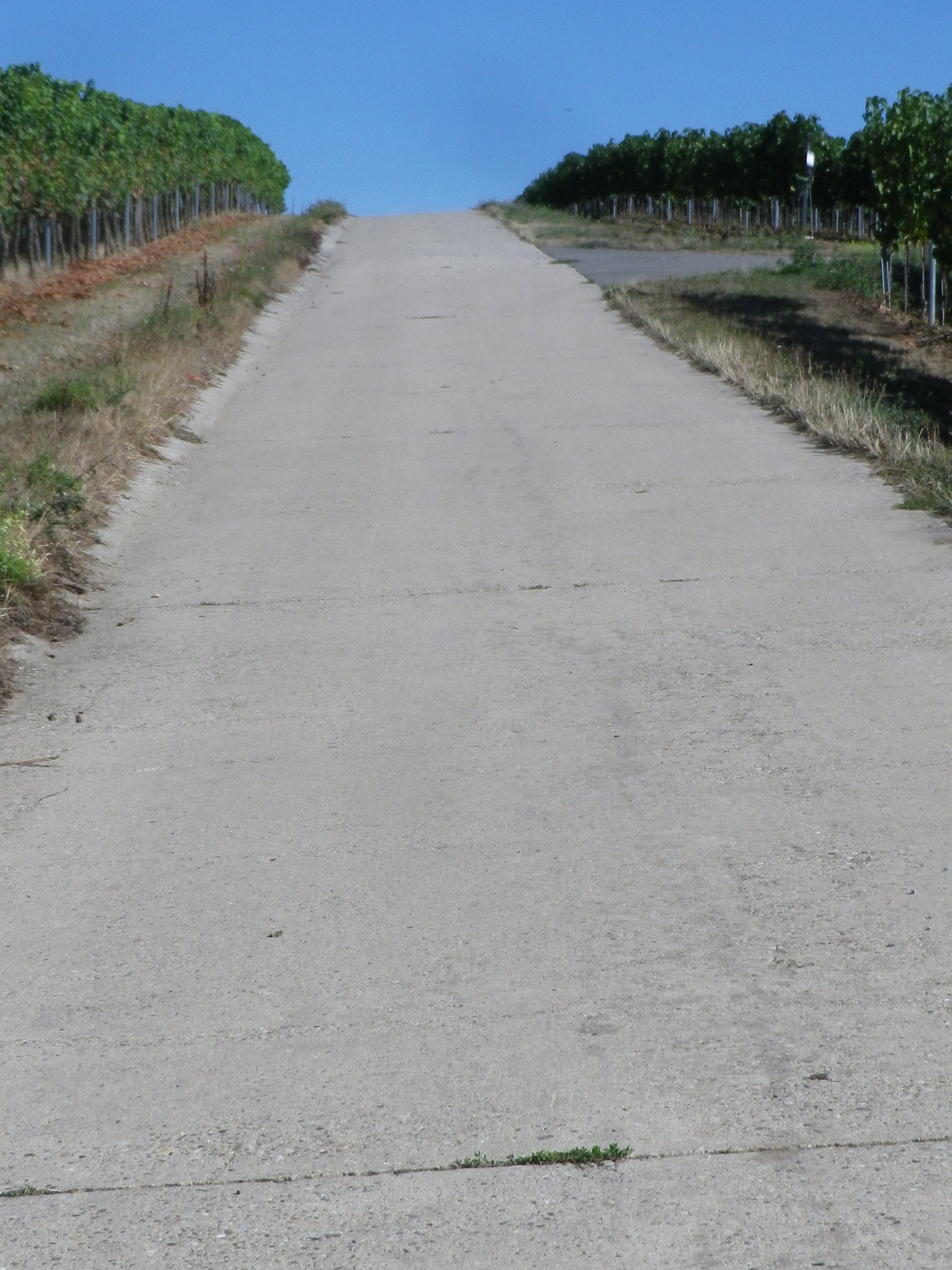
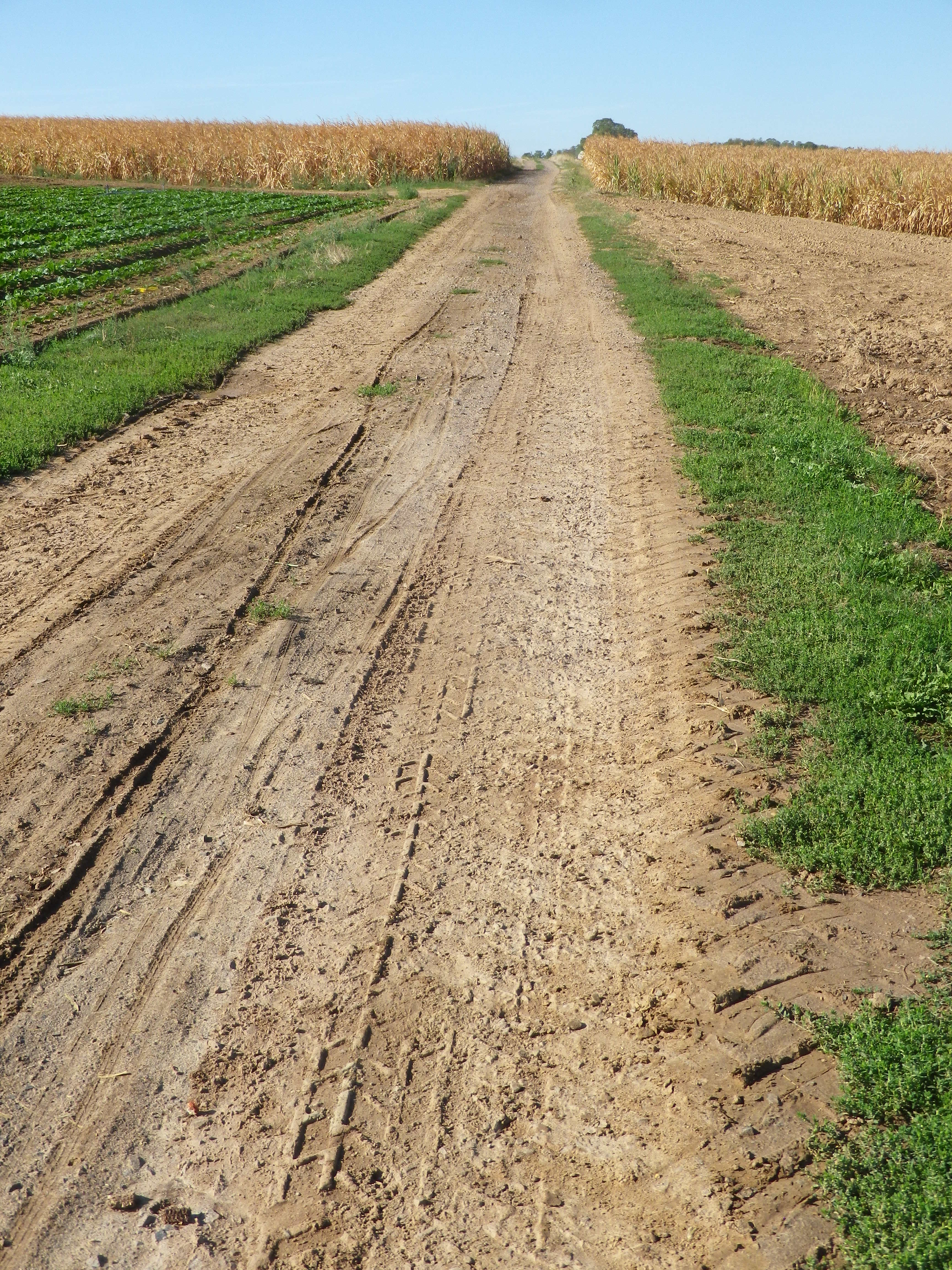
Restrooms:
Nussdorf: On the Weinerlebnispfad, in the vineyards is a small restroom set in a nice rest area.
Landau: Off the trail (but closest and pay) toilets at Am Kronwerk x Fortstr (make sure you have coins)
Attractions on or near Trail:
Seasonal local wine festivals (see below), and wine education paths Nussdorf and Siebeldingen
Tasting along the Trail:
Many wineries along the trail, most notably in Siebeldingen, Nussdorf, Ilbesheim and Godramstein; whereas Landau has a couple of wine taverns/vinoteks. Additionally, Ilbesheim, Heuchelheim-Klingen, Siebeldingen have wine festivals in September
Alternative Options:
Hiking: In Heuchelheim-Klingen, the Weinrundwanderweg, a 13.6-kilometer-long easy circuit hike through the two villages surrounded by a sea of vines. Ilbesheim, by contrast has a number of wine-themed short (2-3 kilometer) circuits. Last but not least is Nussdorf’s Weinerlebnispfad, a unique combination of visual and audio art set in the vineyards along a two-kilometer trail through the vineyards overlooking the mountains and valleys of the Pfalz.
Car: Deutsche Weinstrasse, a thematic car route itinerary of about 100 kilometers, much of it on secondary roads, past vineyards and through charming wine villages, from Bockenheim to the border town of Schweigen-Rechtenbach.)
Additional Information:
Regional: https://landauland.suedlicheweinstrasse.de/
Trail specific: https://www.outdooractive.com/de/route/radtour/pfalz/winzer-radrundweg/3201806/ or
https://vis-a-vis-pamina.eu/en/activities/
Comments:
Not a lot of shade, so perhaps best in cooler weather.
A couple of short, but steep inclines. However, overall, this is an easy to medium difficulty trail.
I included the earthen trail surface photo above to show that even the most degraded surface on this itinerary is quite suitable for most bicycles, except perhaps directly after a very heavy or prolonged rain.
Red Wine Ways
I didn’t know what to anticipate in the Ahrtal, but it certainly wasn’t this: gorgeous, dramatic scenery, and absolutely delicious food and wine, all set in the heart of the river valley of one of the lesser known German wine regions.
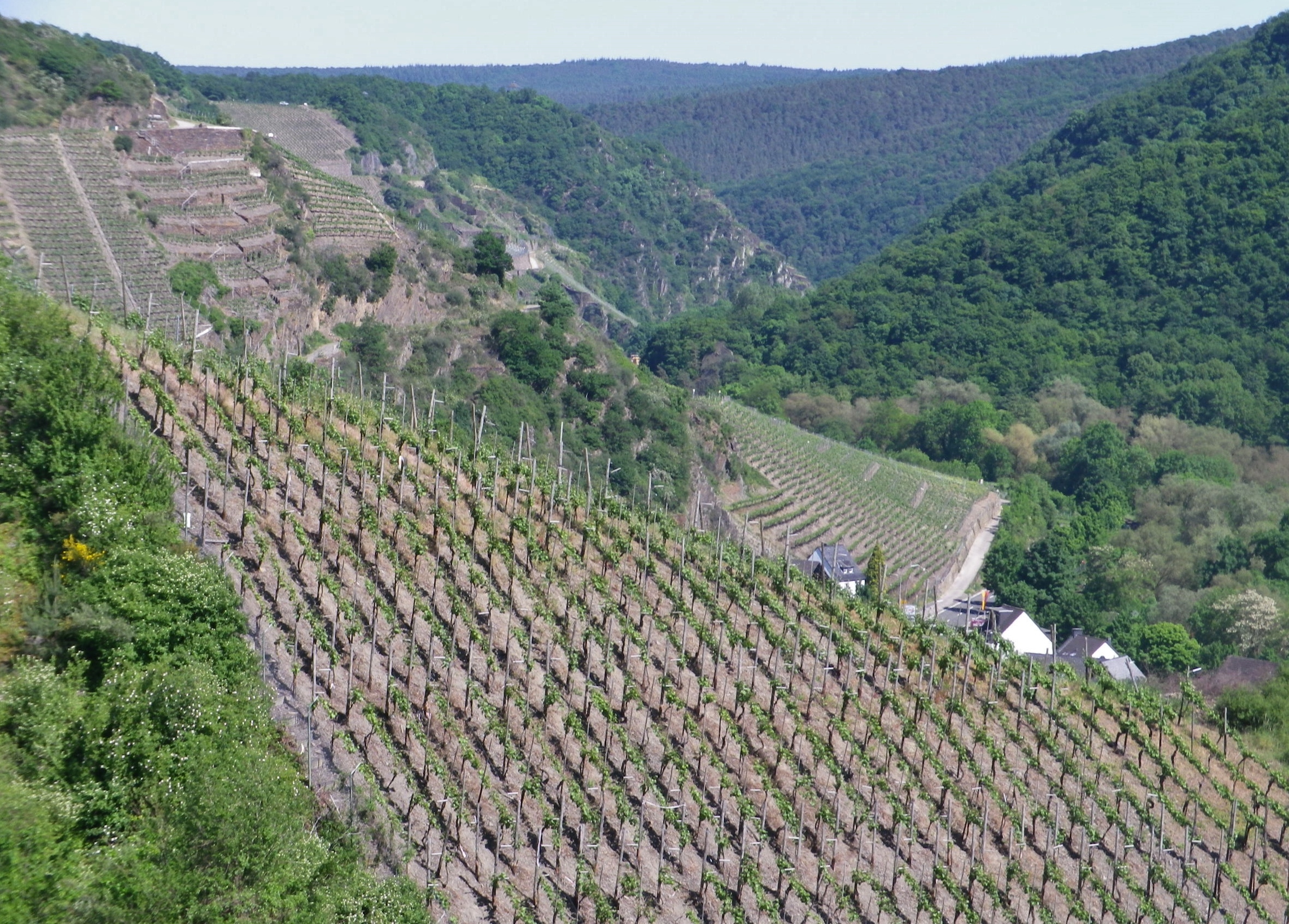
Also unexpected were the steep hills that, by necessity, must accompany such stunning perspectives. And equally unexpected was the excellent red wine. Given its northern latitude, where ripening can prove difficult, good red wine is often challenging to make. Finally, I did not expect such well-developed tourism infrastructure in an area unknown to mass tourism. But Germans certainly knew about it, as the license plates I saw in the towns and villages indicated visitors from all over Germany – and with good reason.
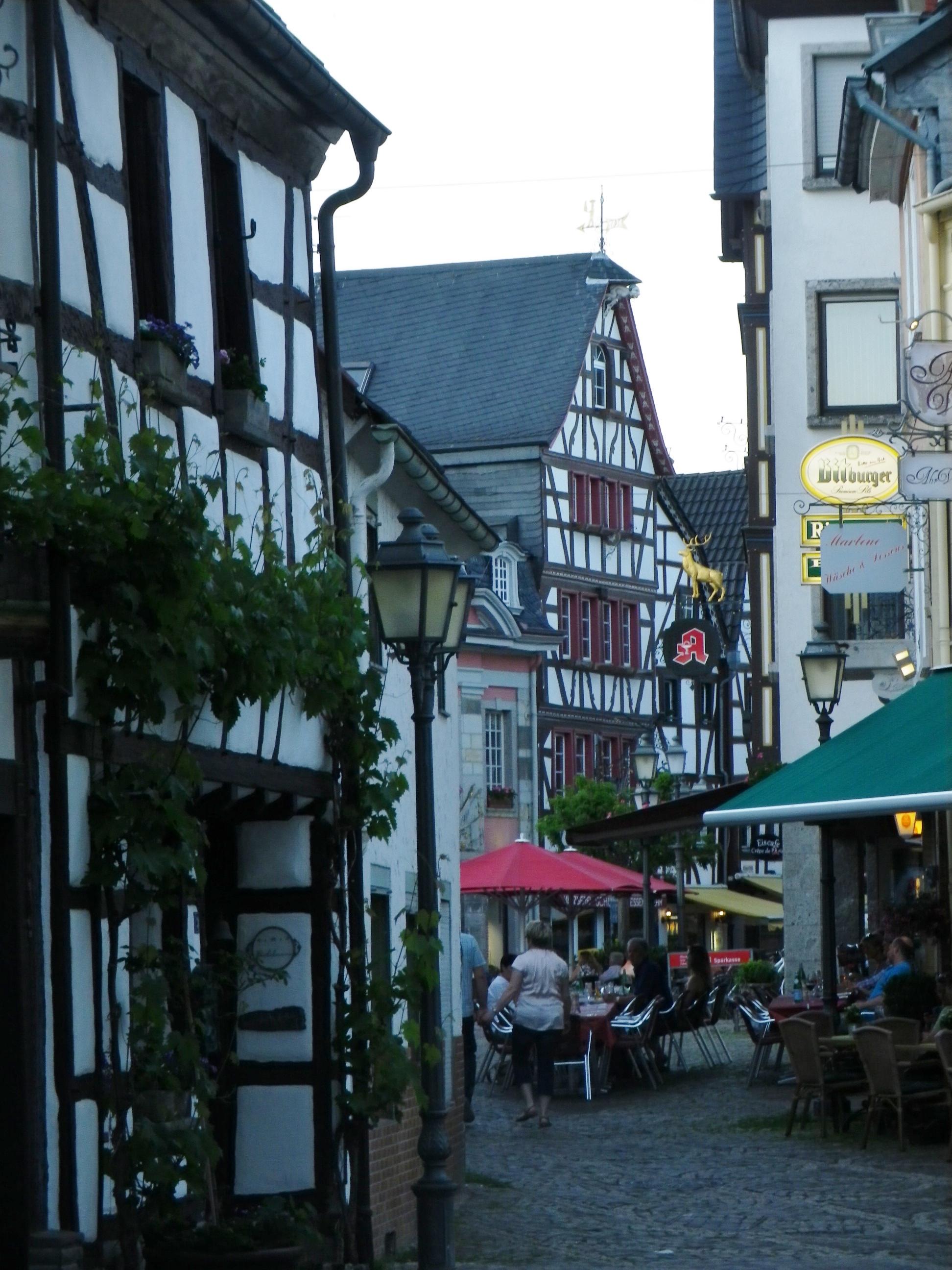
The main town in the area, Bad Neuenahr-Ahrweiler, is a delightful spa town, with all the amenities found in most spa towns: perfectly maintained paths (wheelchair as well as baby carriage accessible) through beautifully manicured parks or gardens; cafes by the dozen where strollers can watch the world go by with a cup of coffee, or a glass of wine in hand; museums and concerts, sometimes even free and outdoors; and, of course, good restaurants. The most important amenity though, pools and spas, are throughout town and in several hotels. (Soaking in a whirlpool of hot water after a long hike is any hiker’s idea of heaven on earth.)
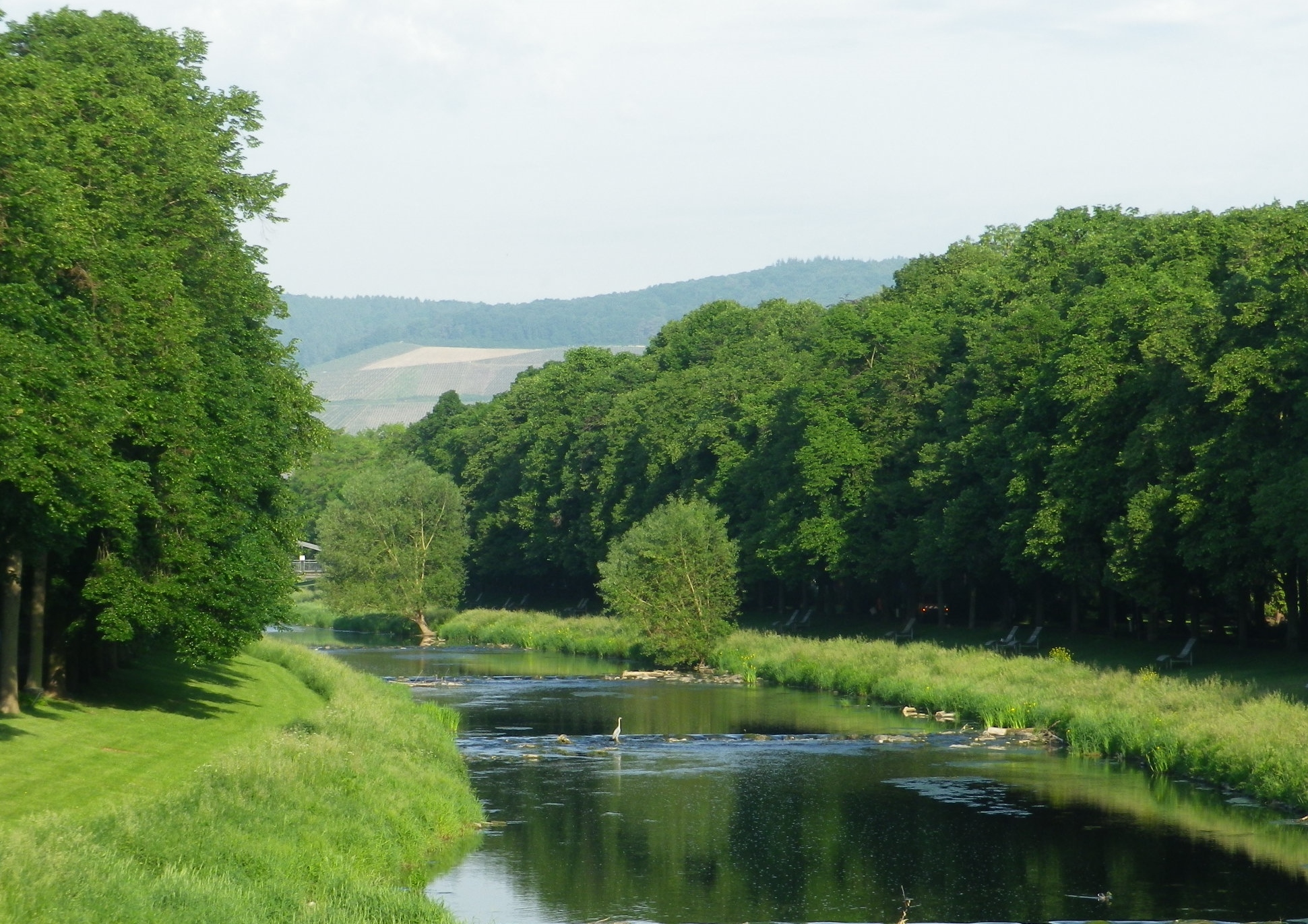
But for those preferring something a bit more strenuous, there is the Rotweinwanderweg. At 35 kilometers, it is designed to be hiked over a couple of days in stages, at your own pace. Conveniently, area hotel guests receive a local rail pass, which was another pleasant surprise! Therefore, it is possible to ride to the start point, in Altenahr, hike your way back down the valley to a point of your choosing, then picking up the following day where you left off the day before.
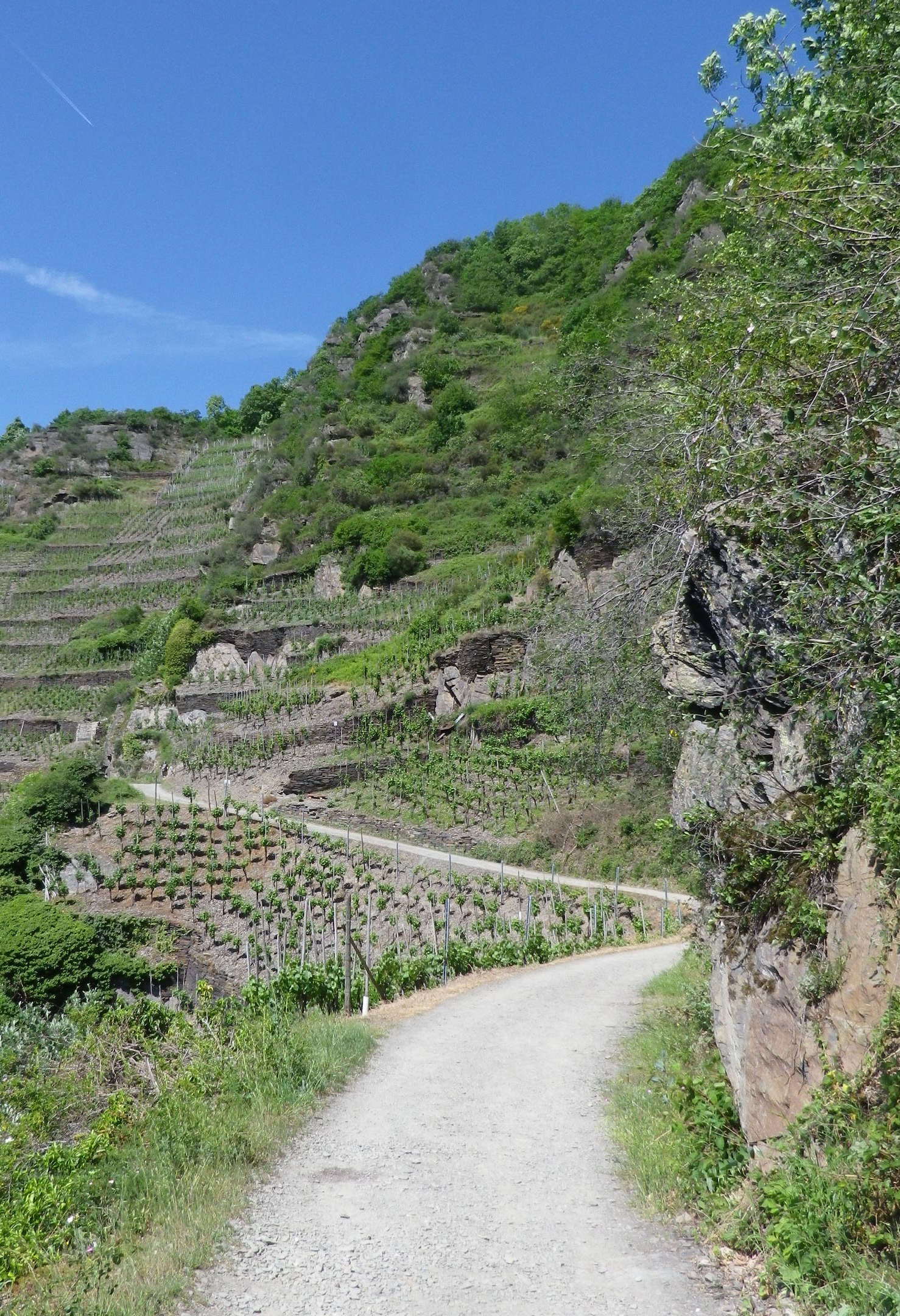
This trail is certainly do-able in two days, but you will want more time! Lovely wine taverns, wine shops and rest areas line the trail in places. While some taverns were in the villages (Dernau was especially full of them), I stopped at one (the Michaelishof) magnificently set in the midst of the vineyards on the outskirts of Mayschoss to sample some food and wine, in spite of being behind schedule.
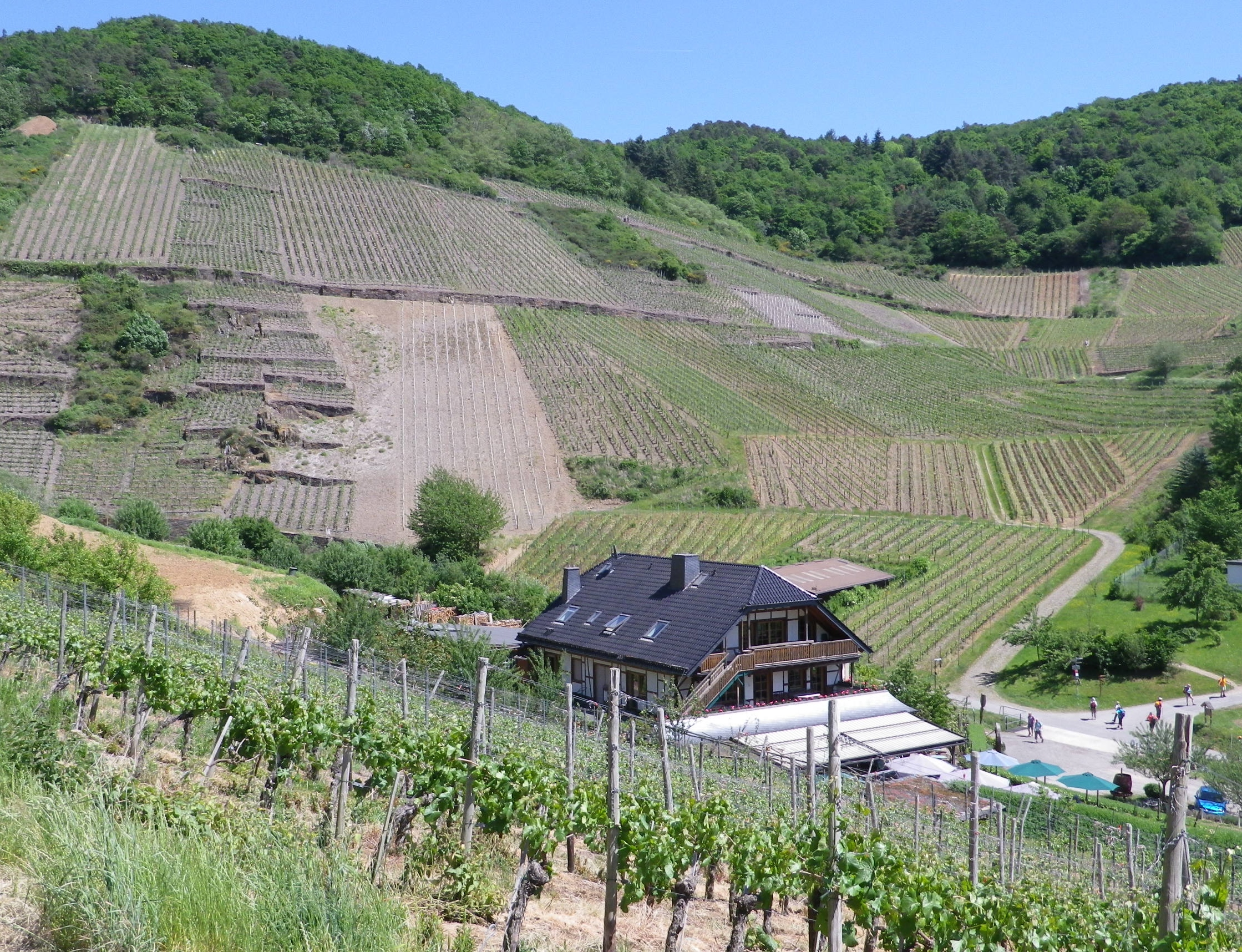
Other places that beg for a stop on the trail are fantastic overlook points, and dramatic cliffside benches. Quiet forest vales also invite hikers to experience a few minutes in shadowy, green tranquility. Sadly, I didn’t have enough time to maximize my enjoyment at each spot, so it was often with a heavy sigh, that I moved on. But at this point, I knew I could definitely count on another unexpected delight around the next bend or atop the next rise – and I was never disappointed.
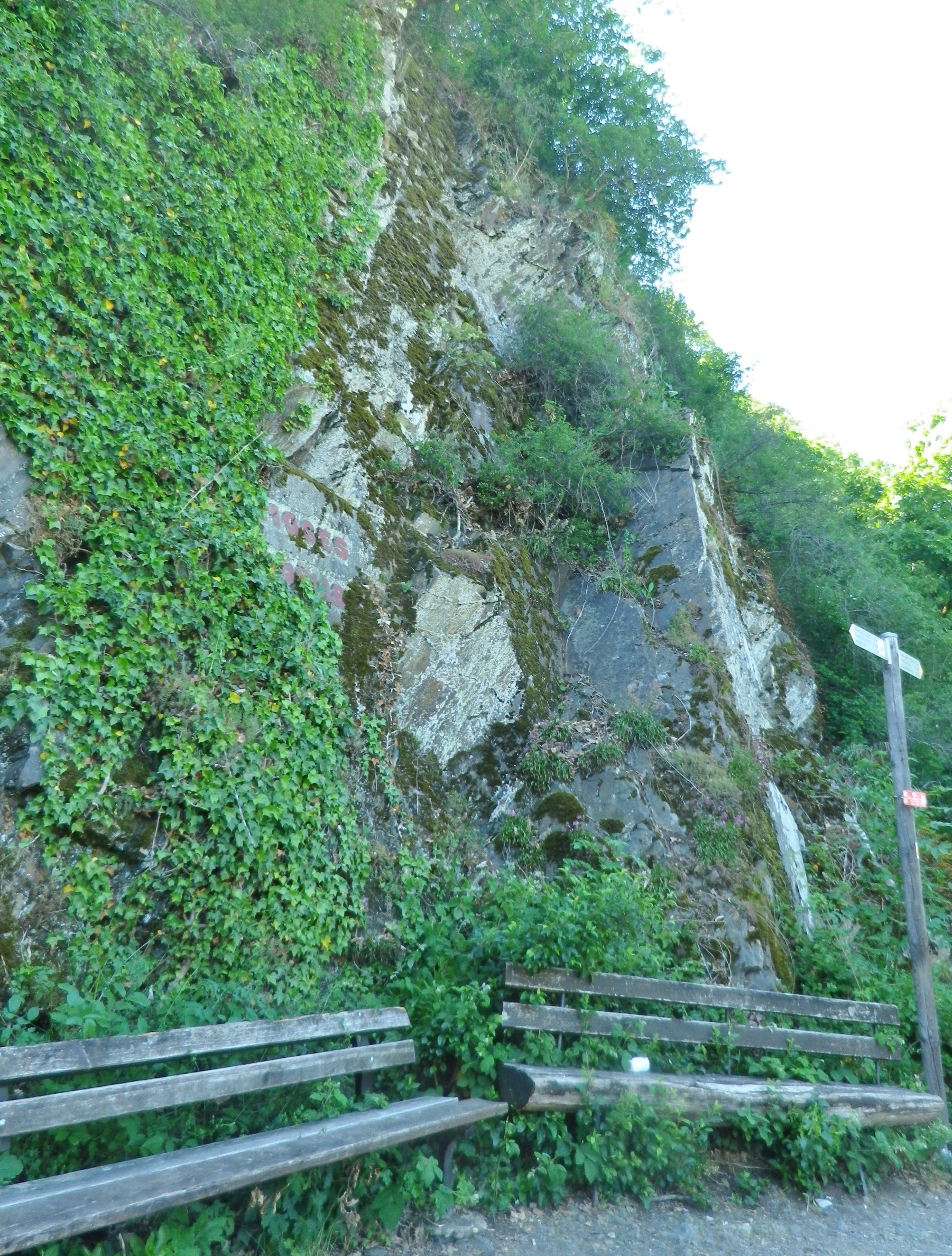
My hike on the Rotweinwanderweg only took me from to Altenahr to Marienthal. That is to say, I only completed the first 13 kilometers of the trail because of personal time constraints. Marienthal is as good a place to stop as any, as it is the site of a former monastery, now home to the Weingut Kloster Marienthal. Set in a hidden, narrow draw lined by vineyards on one side of the road, and tall pines on the other, its historic building contains an impressive wine shop, a wine bar, and a garden café. It was a fitting way to end my hike on this trail, which also included an unexpected desire to return someday to finish this great trail.
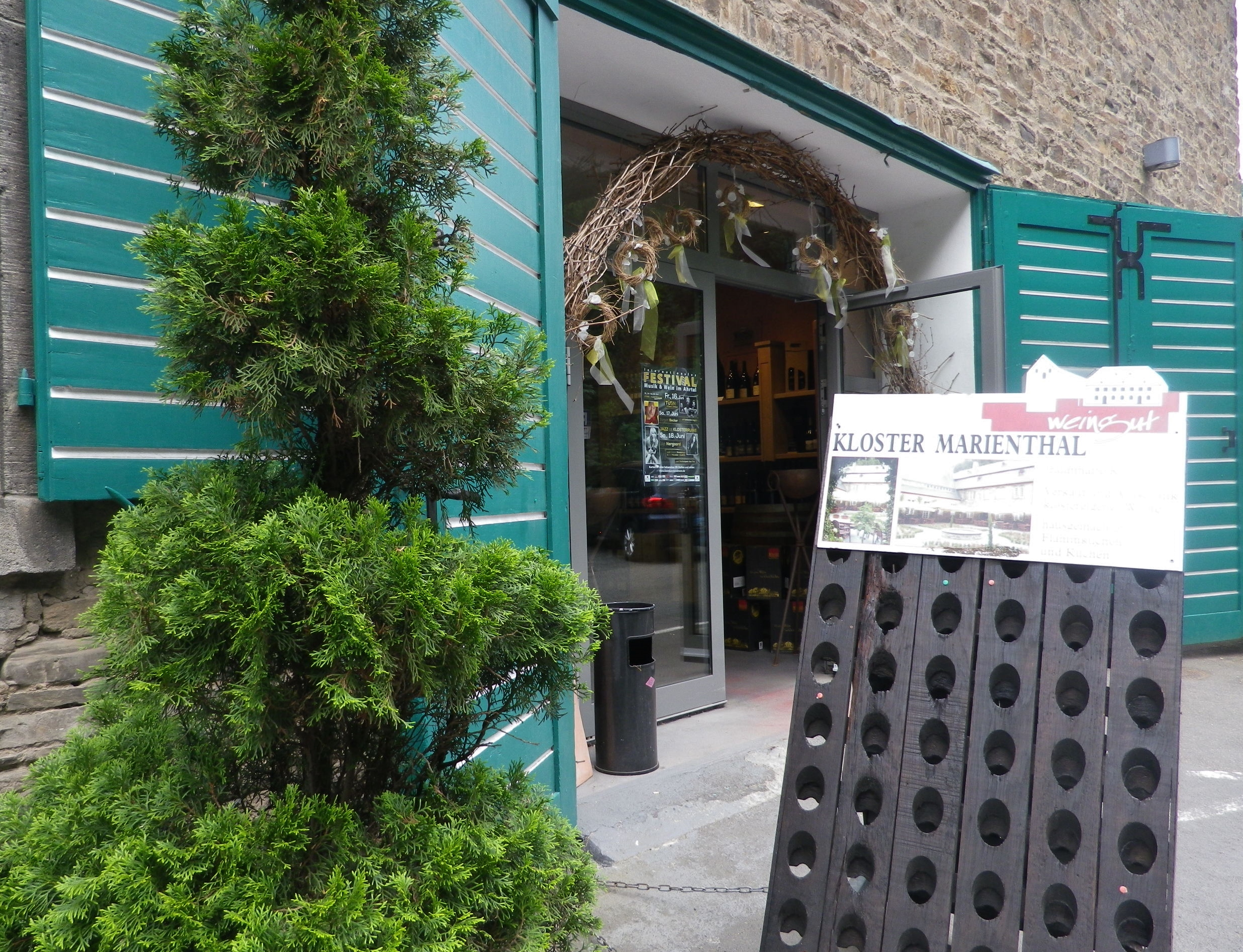
Wine Notes: German Ahr Wine Region
What I Learned
Germany’s Ahr Wine Region, almost 50 kilometers north of the Moselle at Koblenz, is the Rhineland-Palatinate’s northern-most wine region, though it is not Germany’s northern most wine region. (That honor goes to the Saale-Umstrut region in Saxony.) But it is the furthest north red wine region in Germany. Until seen, it would be hard to credit that red varietals could ripen well enough this far north. But the vines grow on steep, mostly south-facing slopes of volcanic rock, along a very narrow valley that runs (in a very serpentine fashion) from west to east. Nature and geologic activity have combined to create some ideal conditions for red varietals here, with volcanic stone soils in the western end of the valley, and loess soils in the eastern end of the valley, as it approaches the Rhine.
With only about 560 hectares, it is one of the smallest wine regions in Germany. Red wine predominates, with about 540 of those 560 hectares dedicated to red varietals. Spaetburgunder (Pinot Noir) is the most widely planted varietal, but Domina, Regent, as well as Dornfelder and Portugieser, are other red varietals that are widely planted throughout the Ahr valley. The red Fruehburgunder varietal is a regional specialty.
Wine making has historically been a cooperative affair here. Kloster Marienthal, founded in 1137, has a long history of wine-making. As the name implies, it was formerly a monastery, which needed wine for its services. Abandoned for over 100 years, it became the state wine domain in 1925. A near-by wine cooperative (winzergenossenschaft) claims to be the oldest wine cooperative in the world. The Mayschoss-Altenahr cooperative was founded in 1868 with 18 vintner members, now boasts about 420!
One final word about the wines here: It is especially difficult to find Ahr wine outside the region!
What I Tasted
2016 Spaetburgunder, Blanc de Noir, Trocken, Deutsche Qualitaetswein, Winzergenossenschaft Mayschoss Altenahr: A dry red wine vinified white, a light medium gold color with a slight tinge of pink; floral nose, with floral, vanilla and slight ripe peach flavor, very smooth overall.
2015 Rose, Heimat, Trocken, Deutschen Qualitaetswein, Josten Klein: A dry red wine (Spaetburgunder) with dark salmon pink color; floral and red berry nose, with berry and mineral flavors; very mild tannins.
2015 Spaetburgunder, Ahr-Rose, Trocken, Qualitaetswein bA, Weingut Meyer-Naekel, VDP (Dernau): A dry rose wine with pink grapefruit color, floral and sweet berry nose, with flavors of the same; slightly tart, with no appreciable tannins.
Sekt, Cuvee CK, Brut, Winzerhof Koertgen (Ahrweiler): A dry, sparkling wine cuvee (Pinot Noir, Weissburgunder, Chardonnay), with medium gold color and lively bubbles; slight floral and yeast notes on the nose, with fruity and bread flavors; medium acidity.
